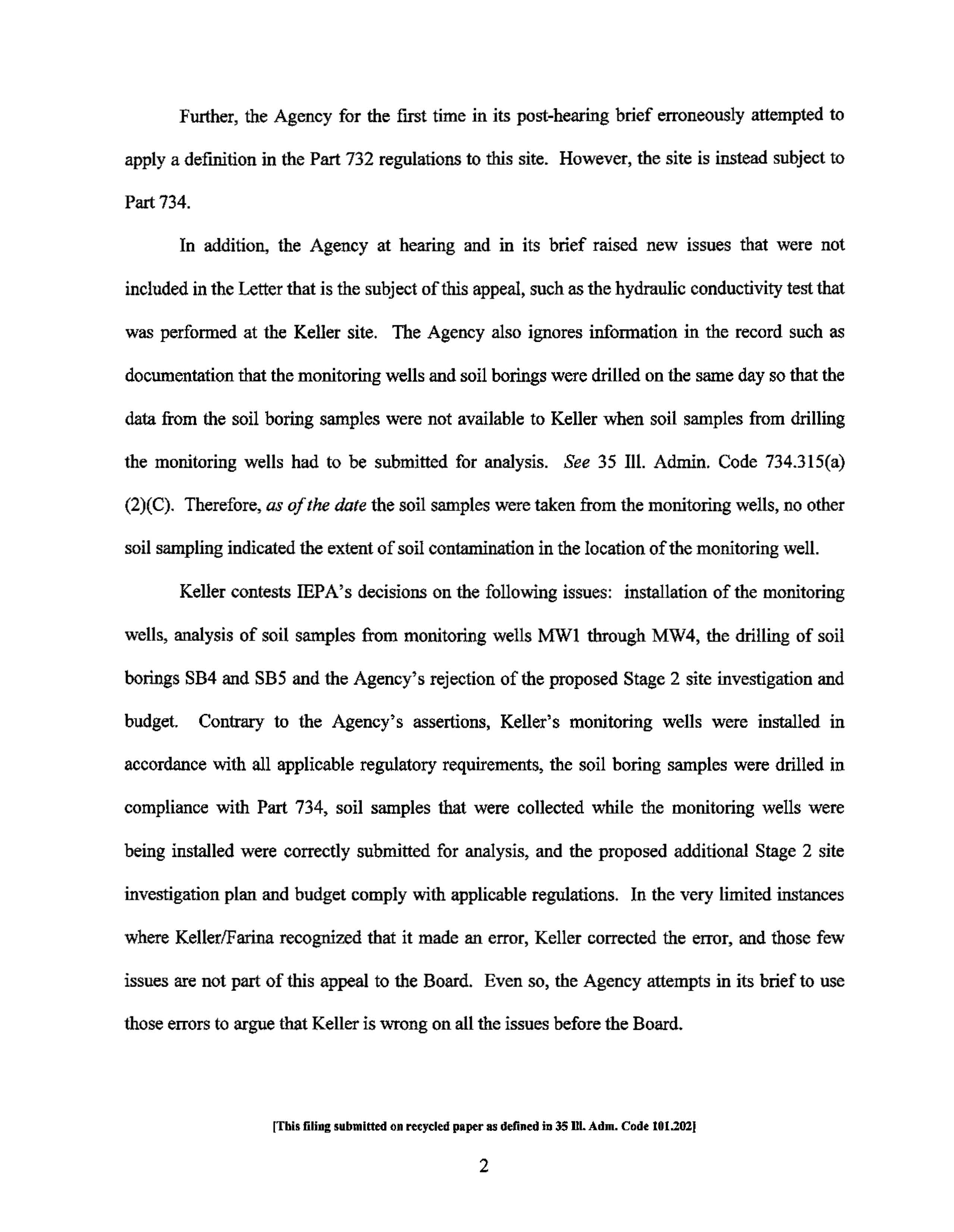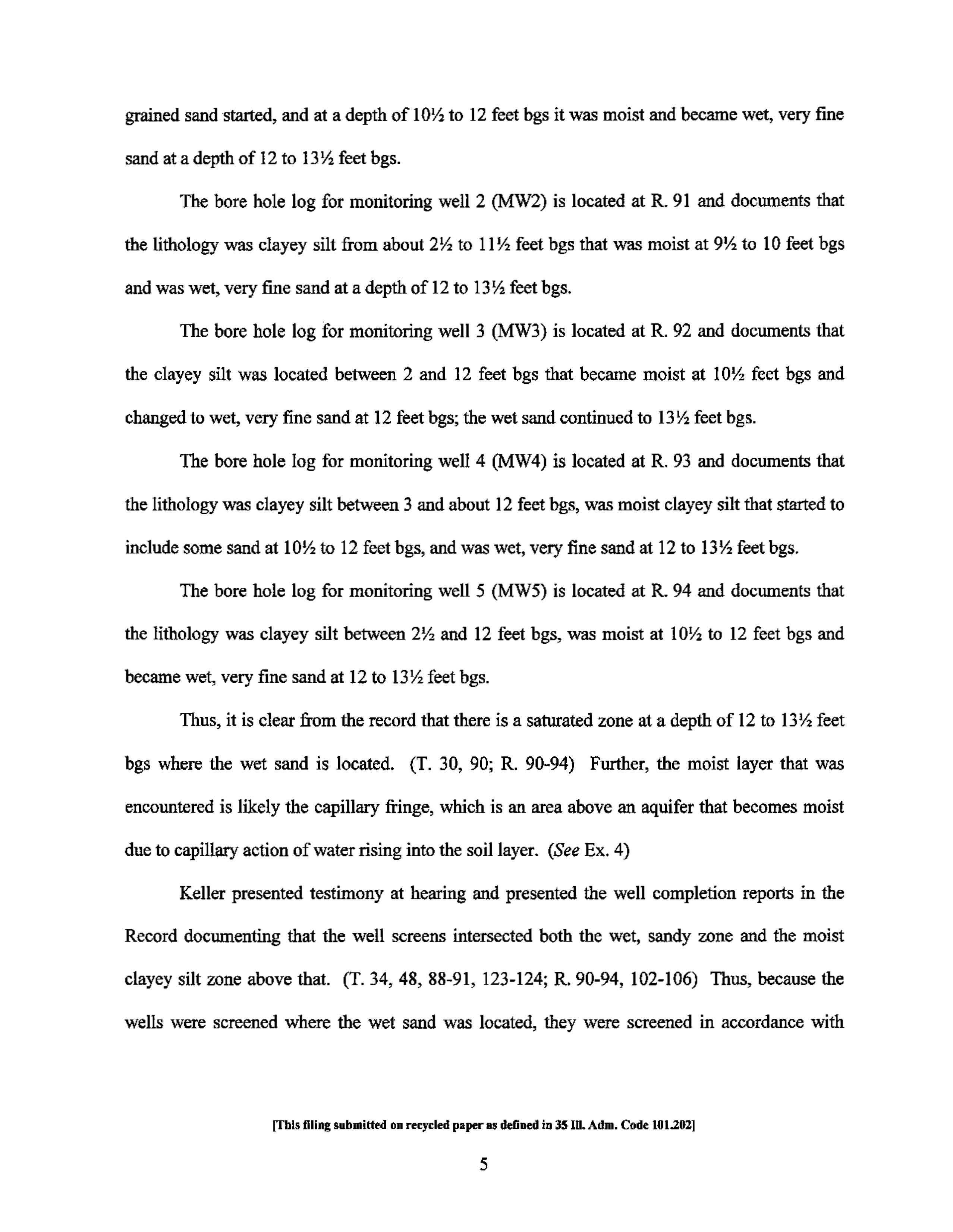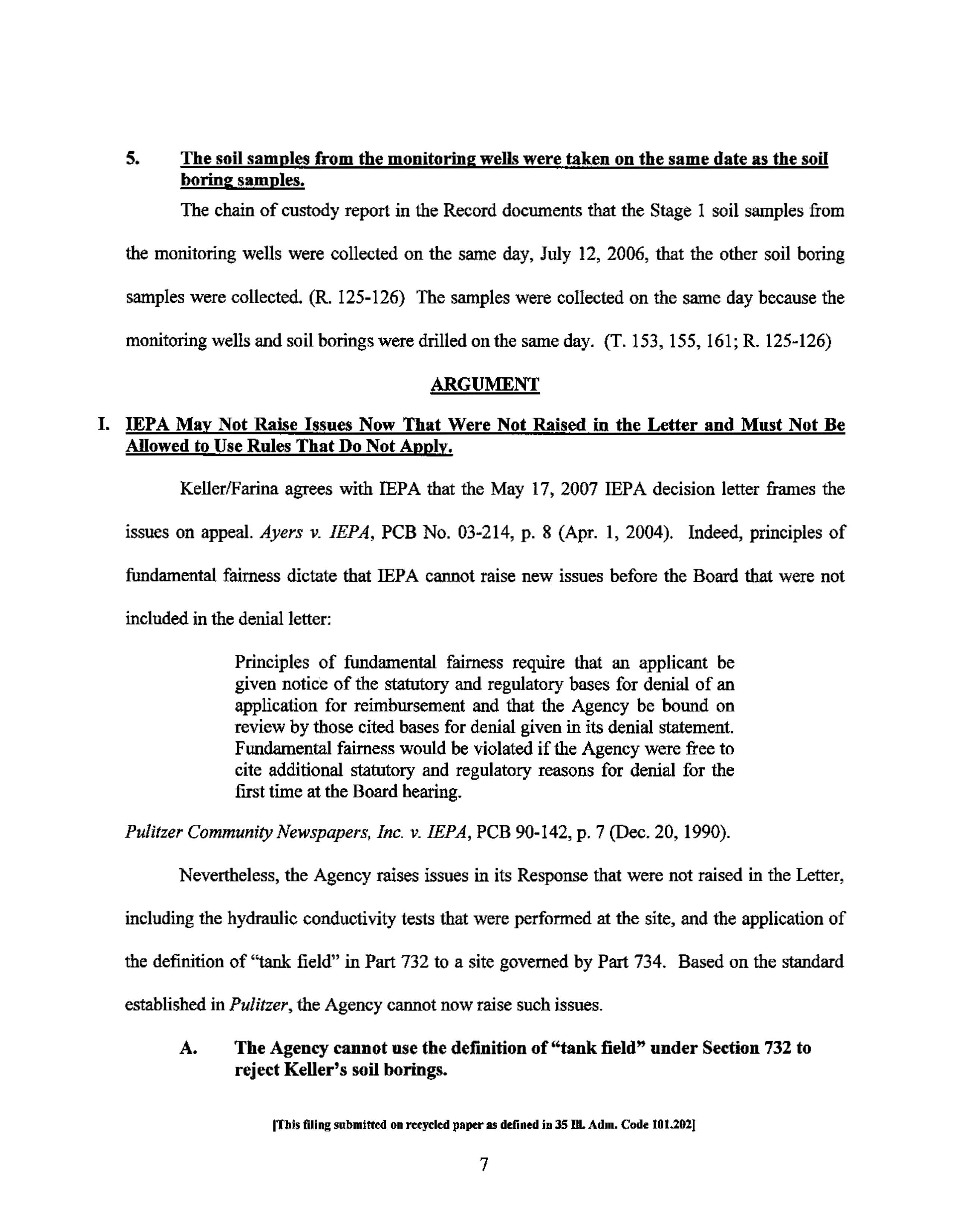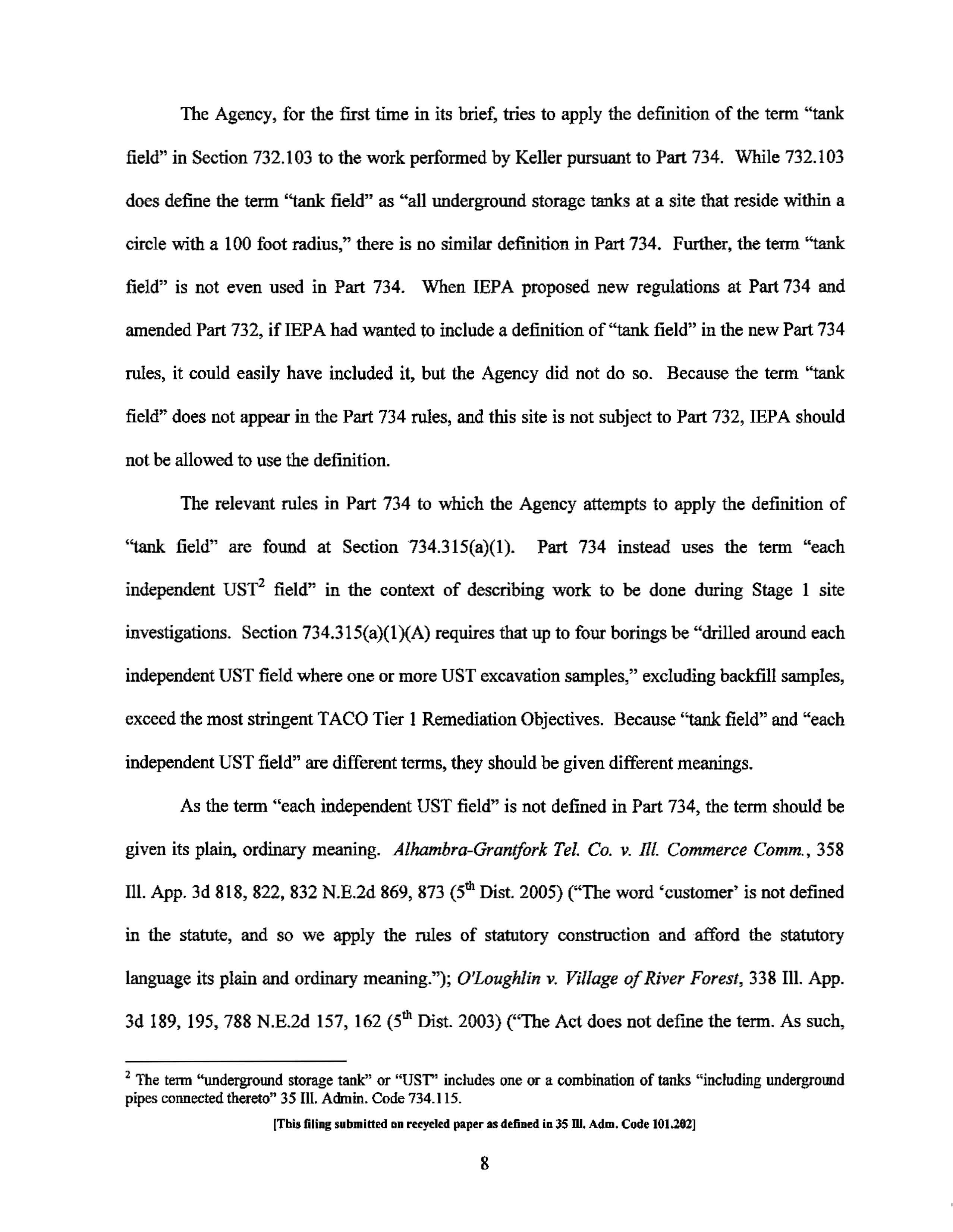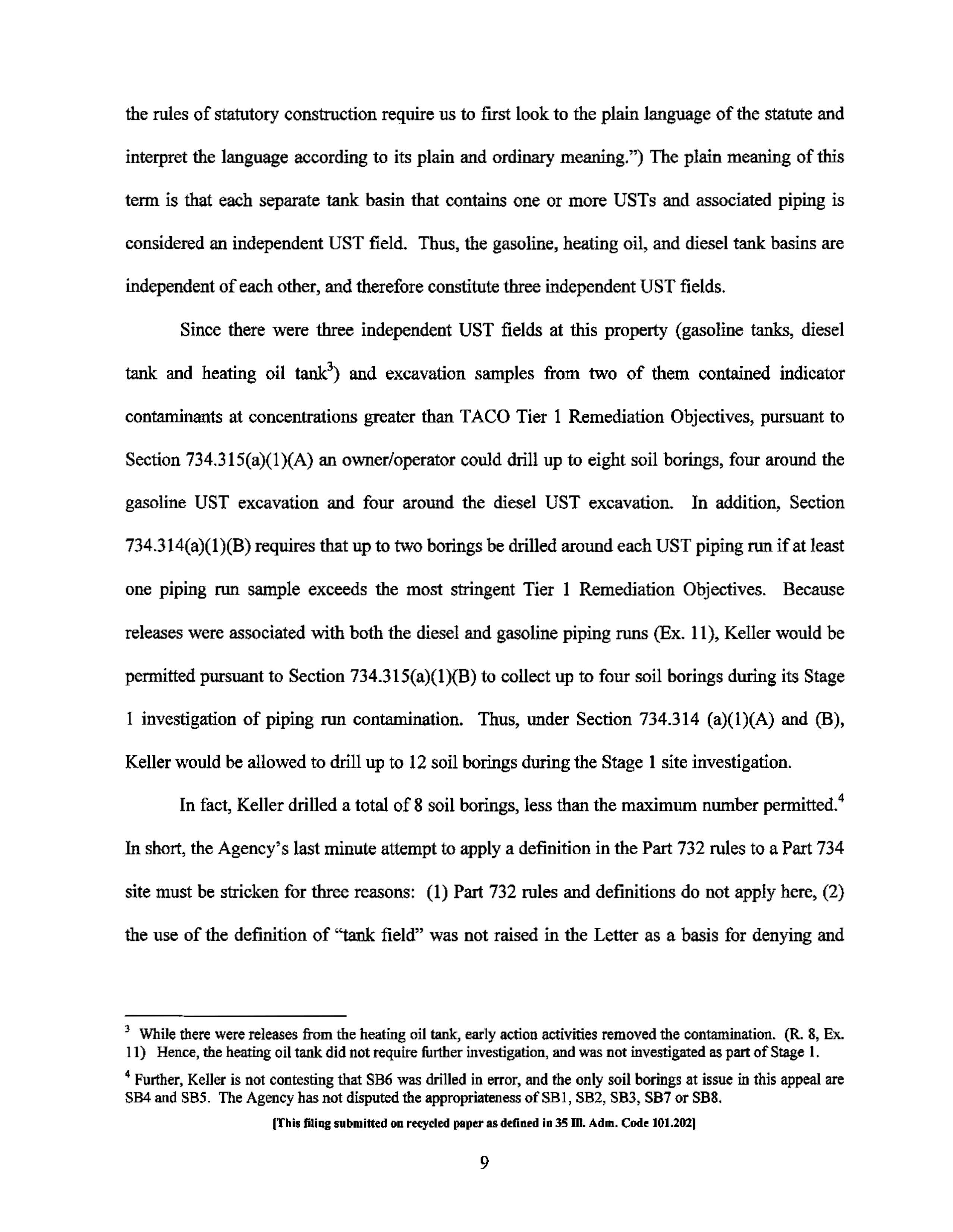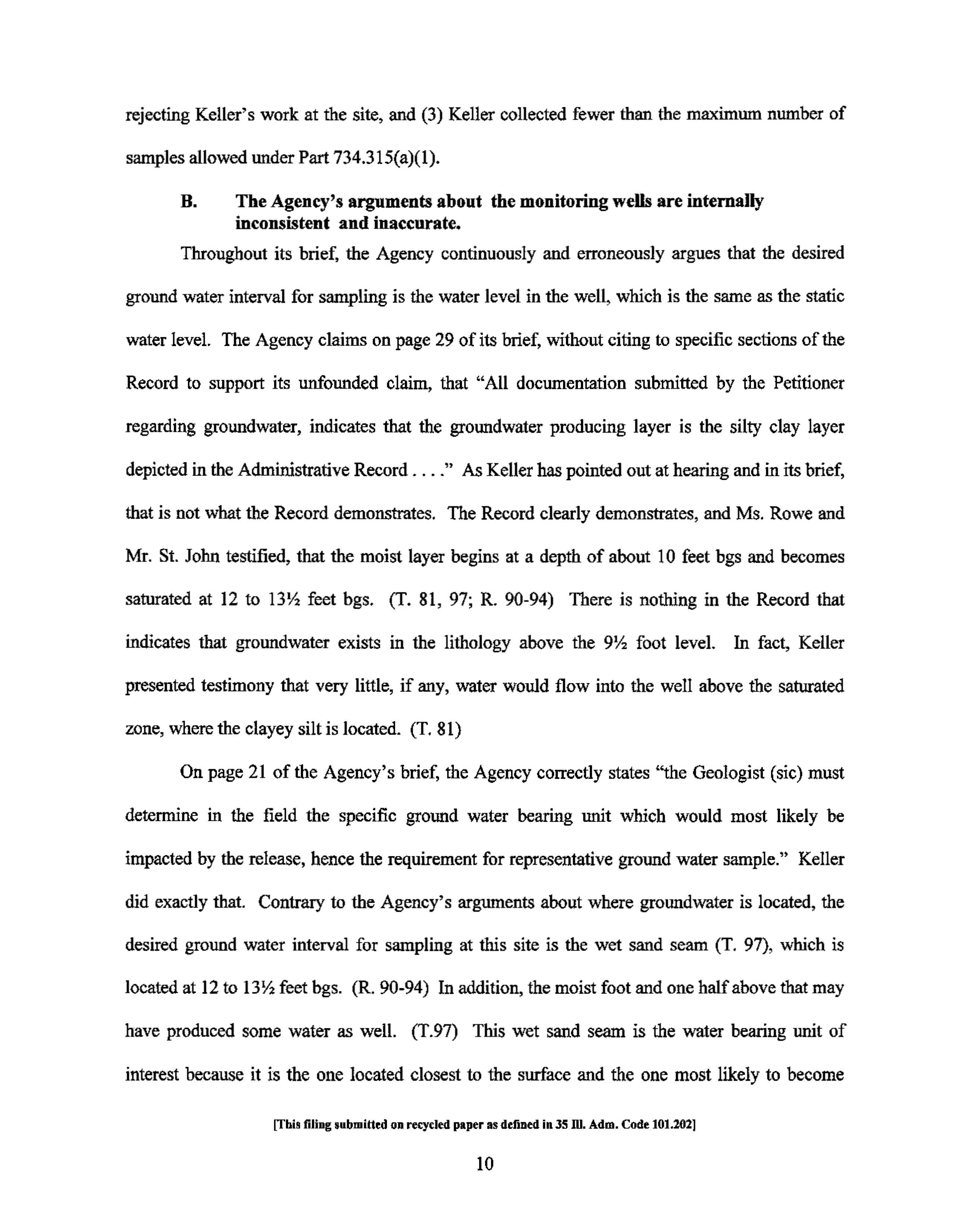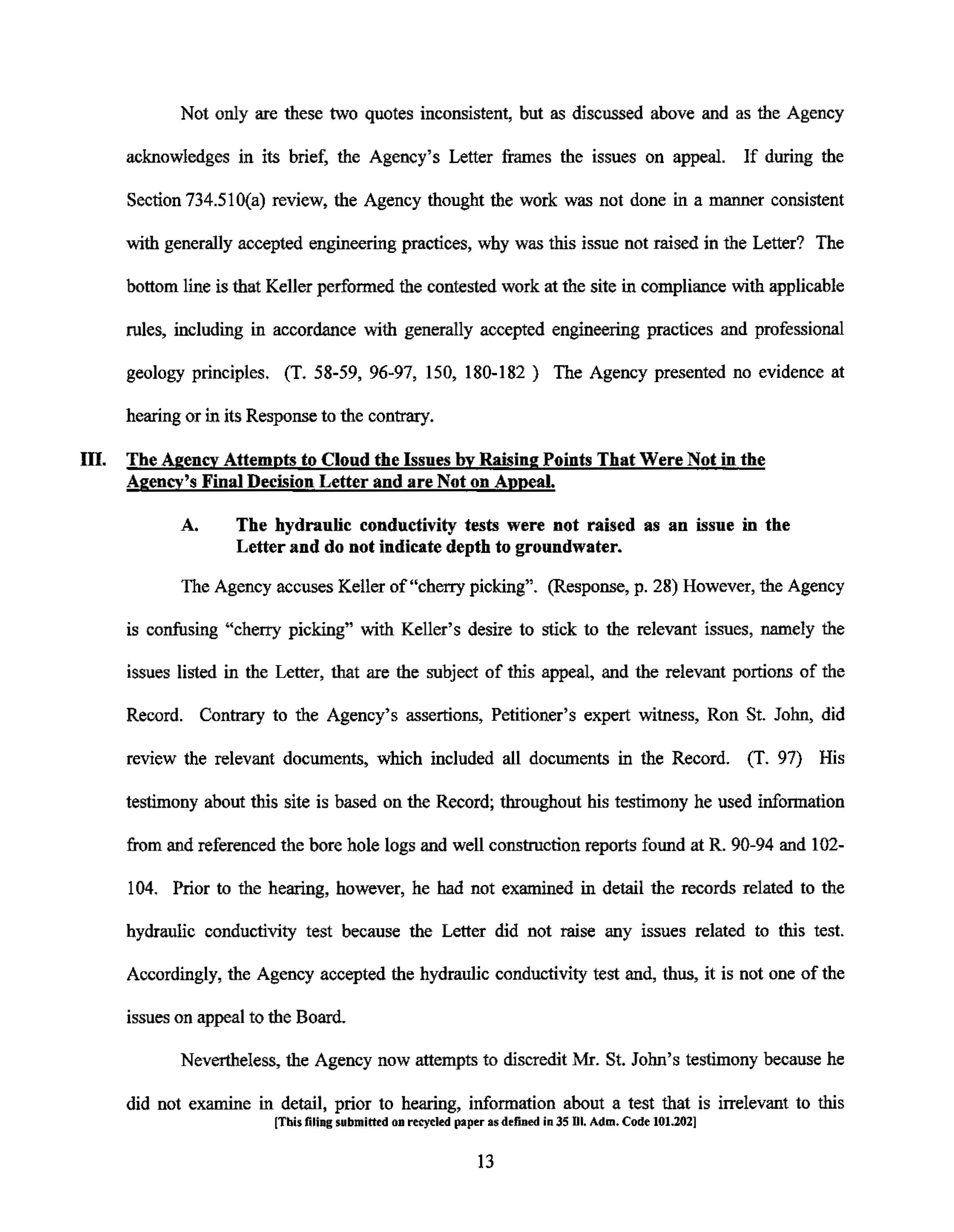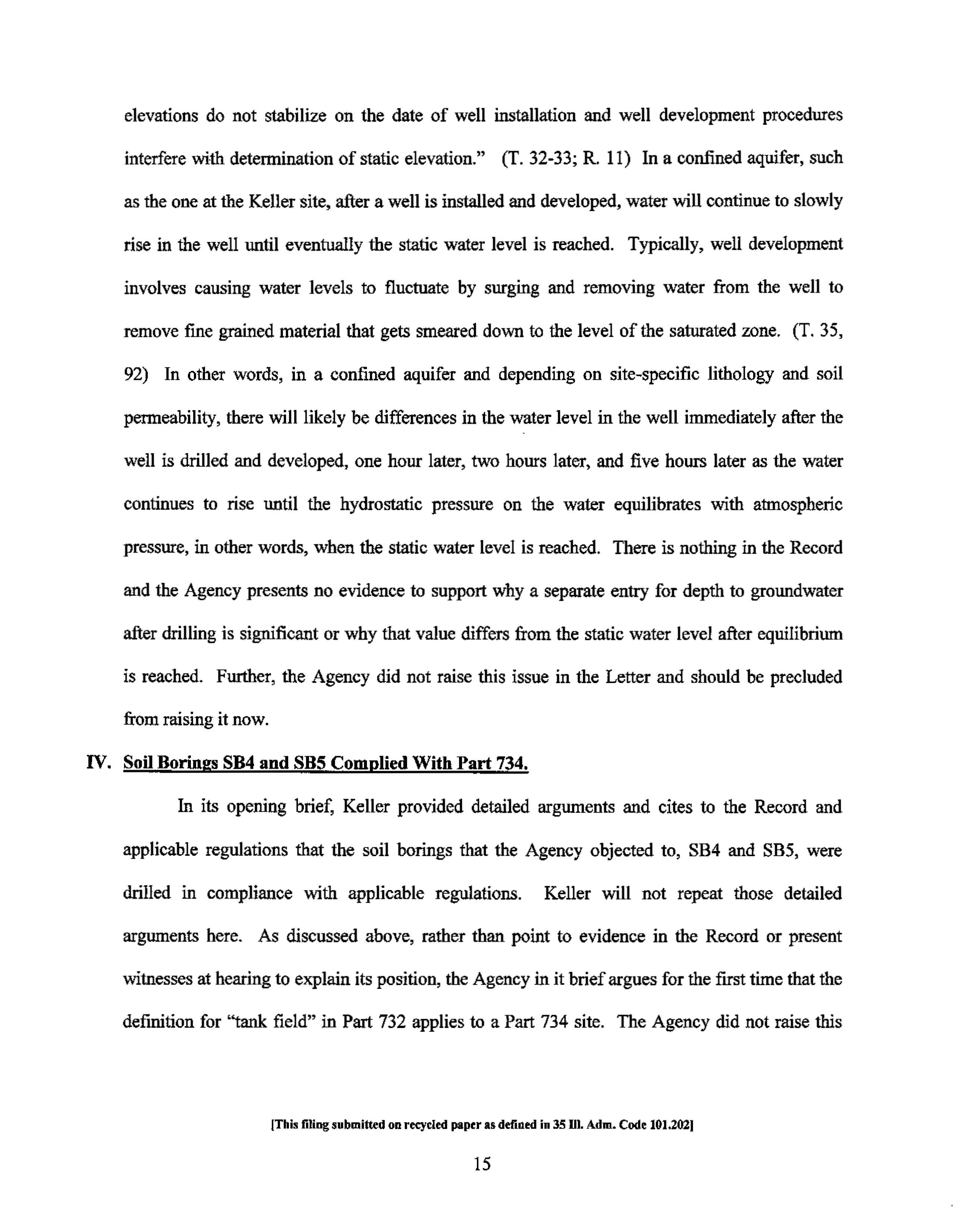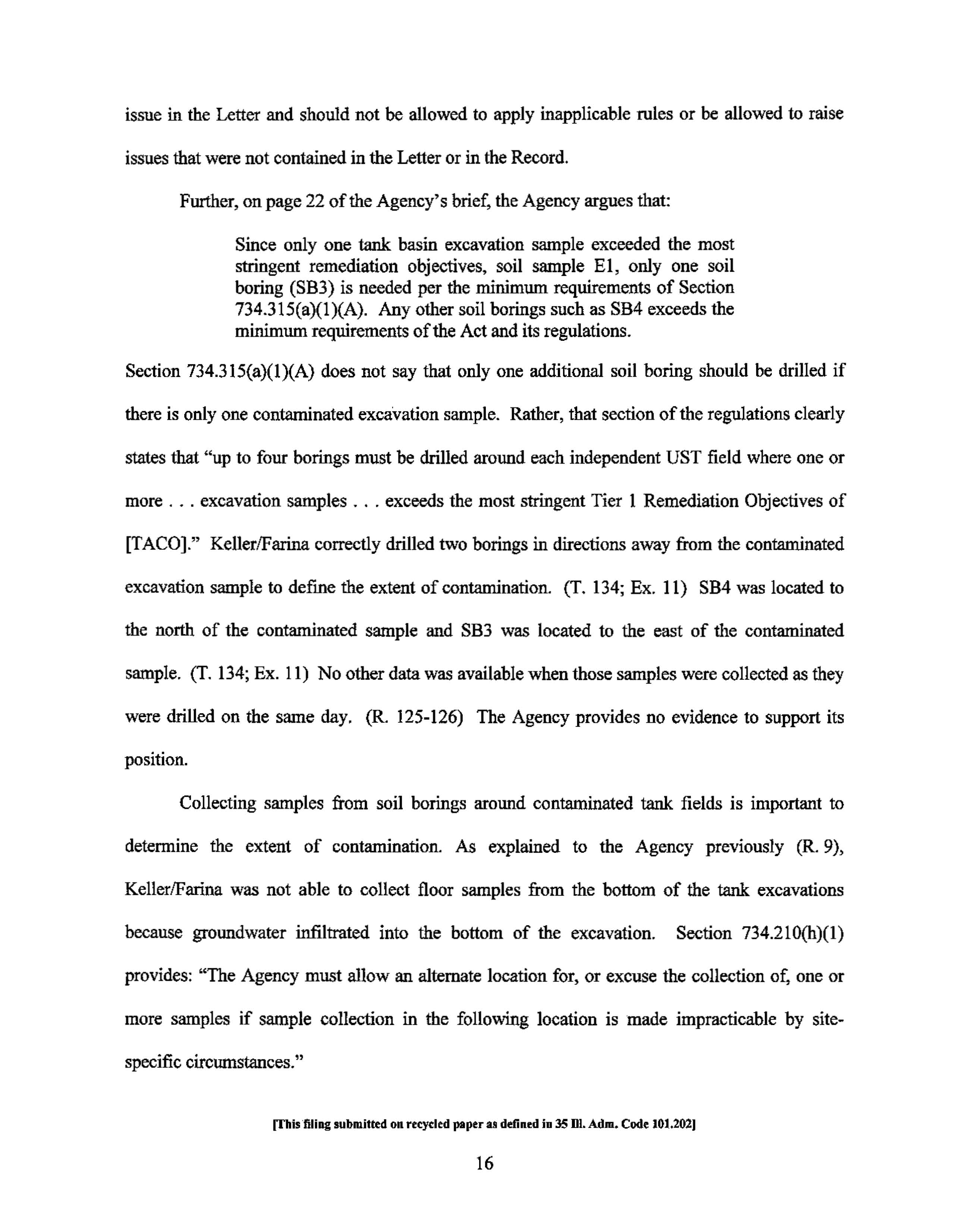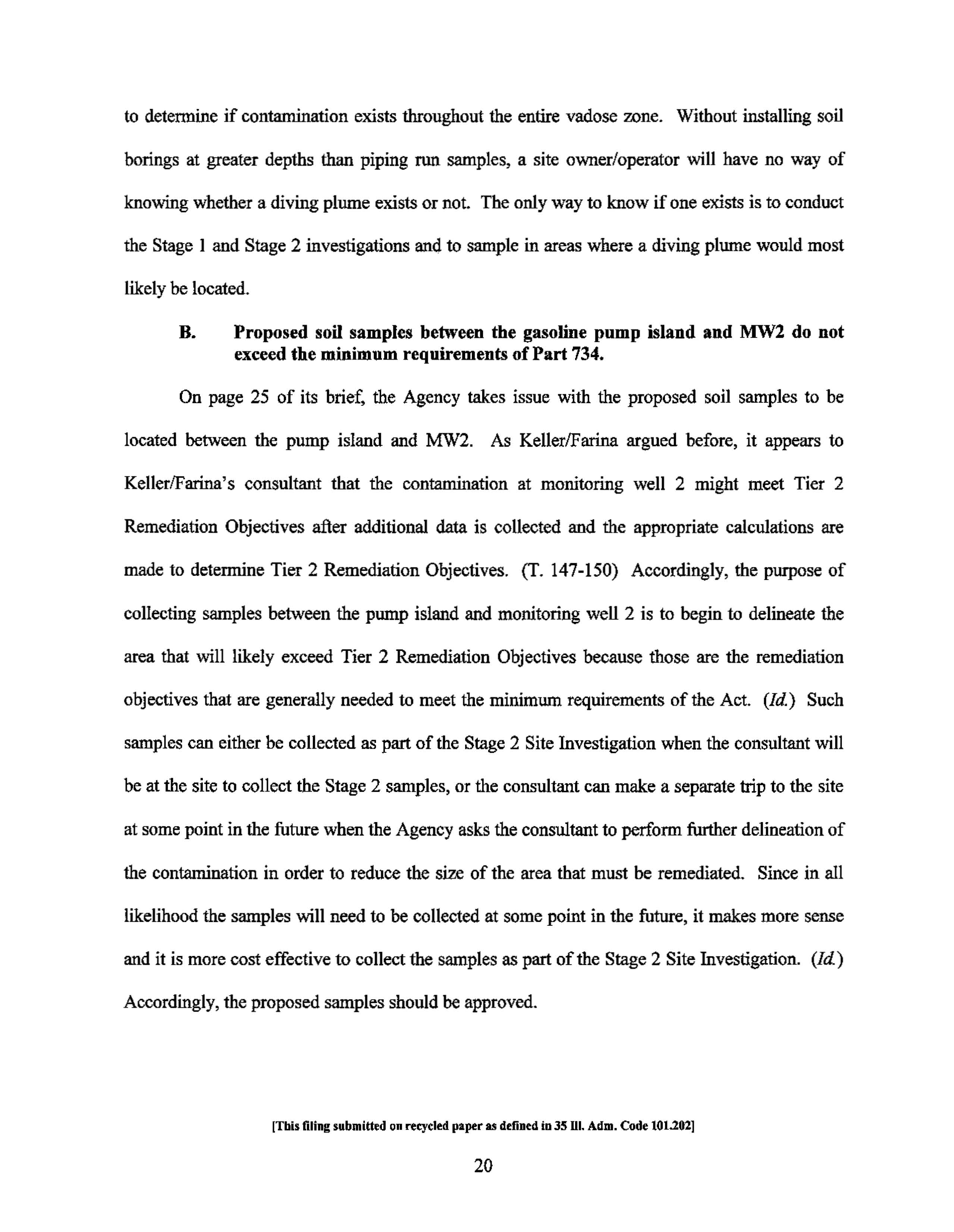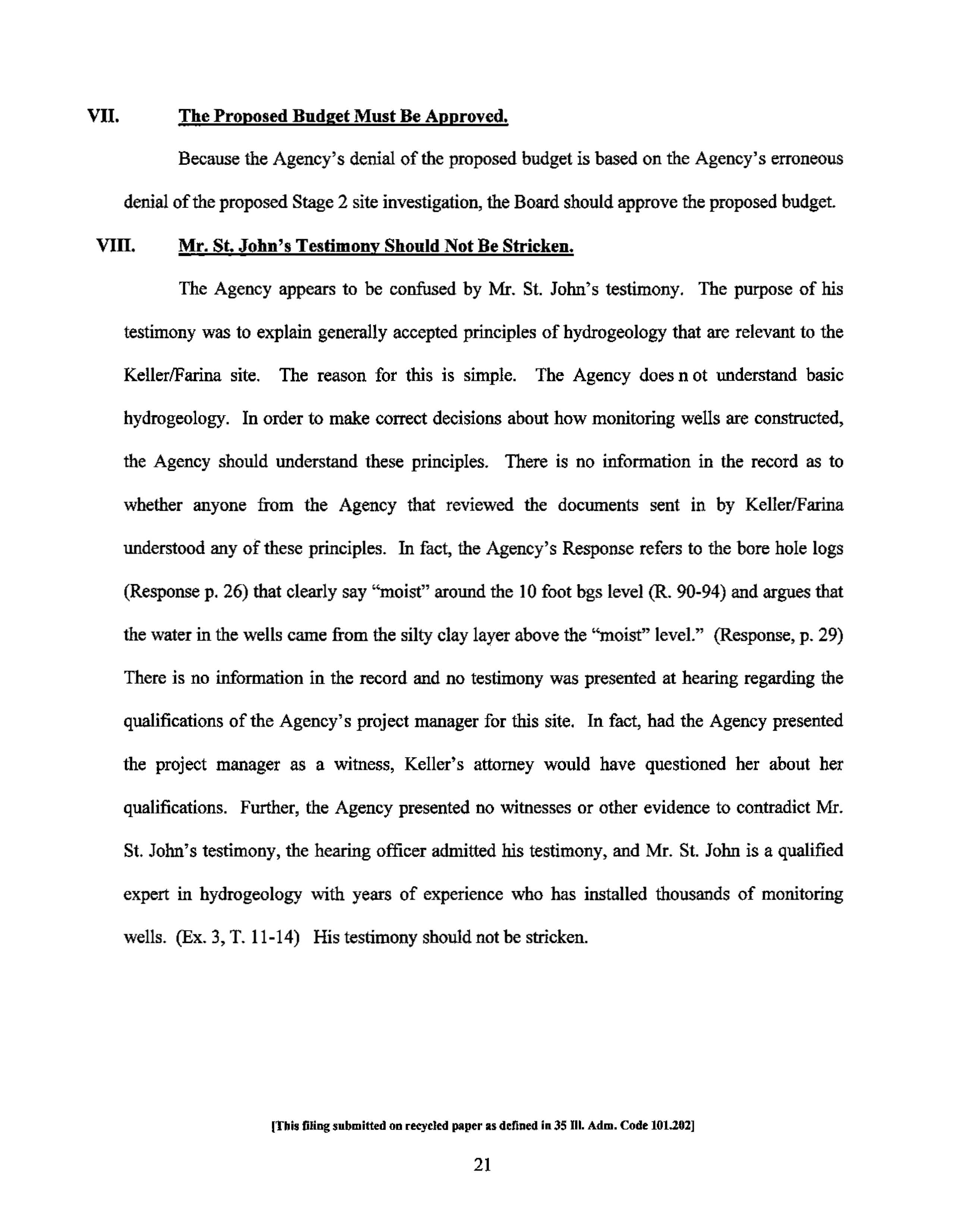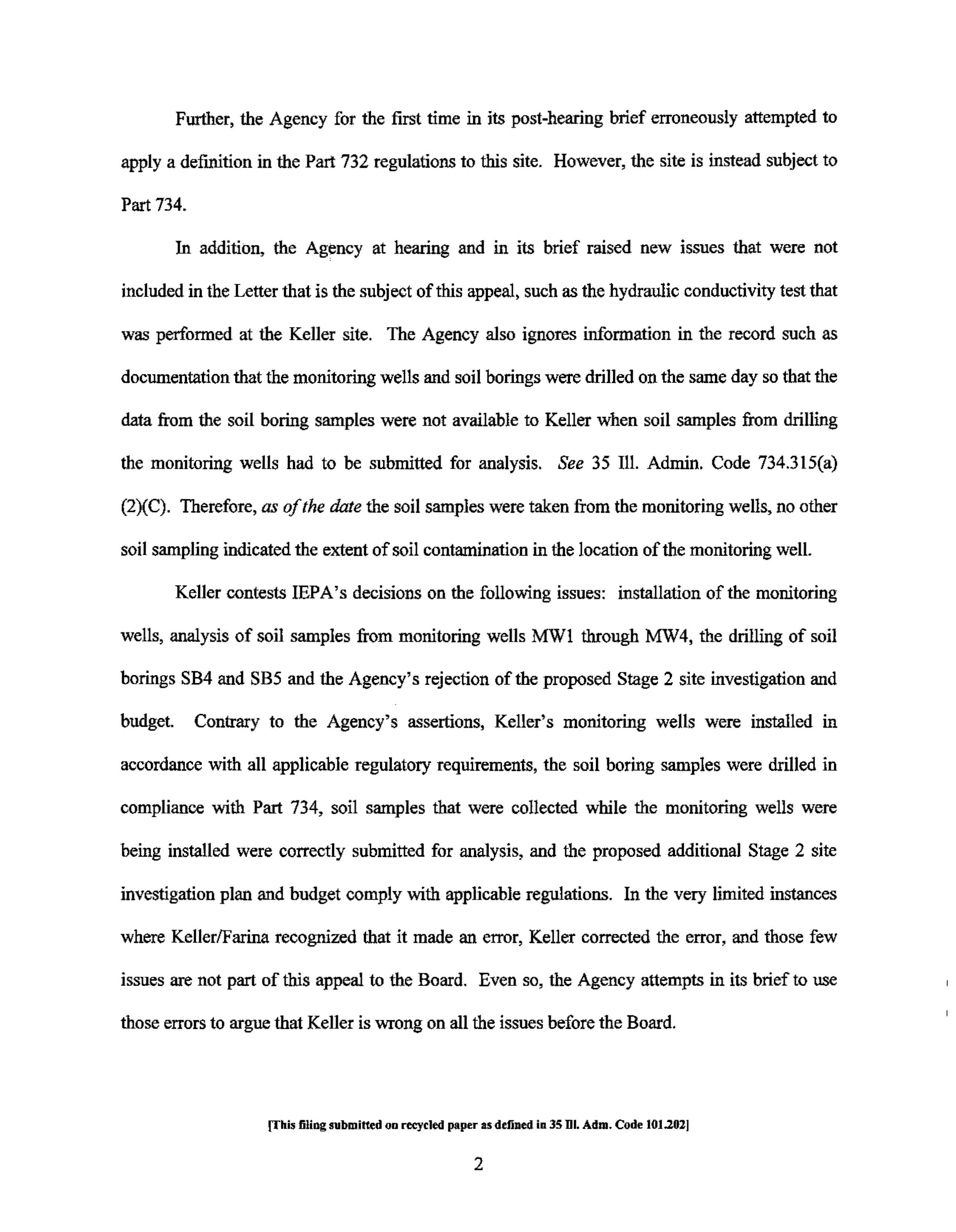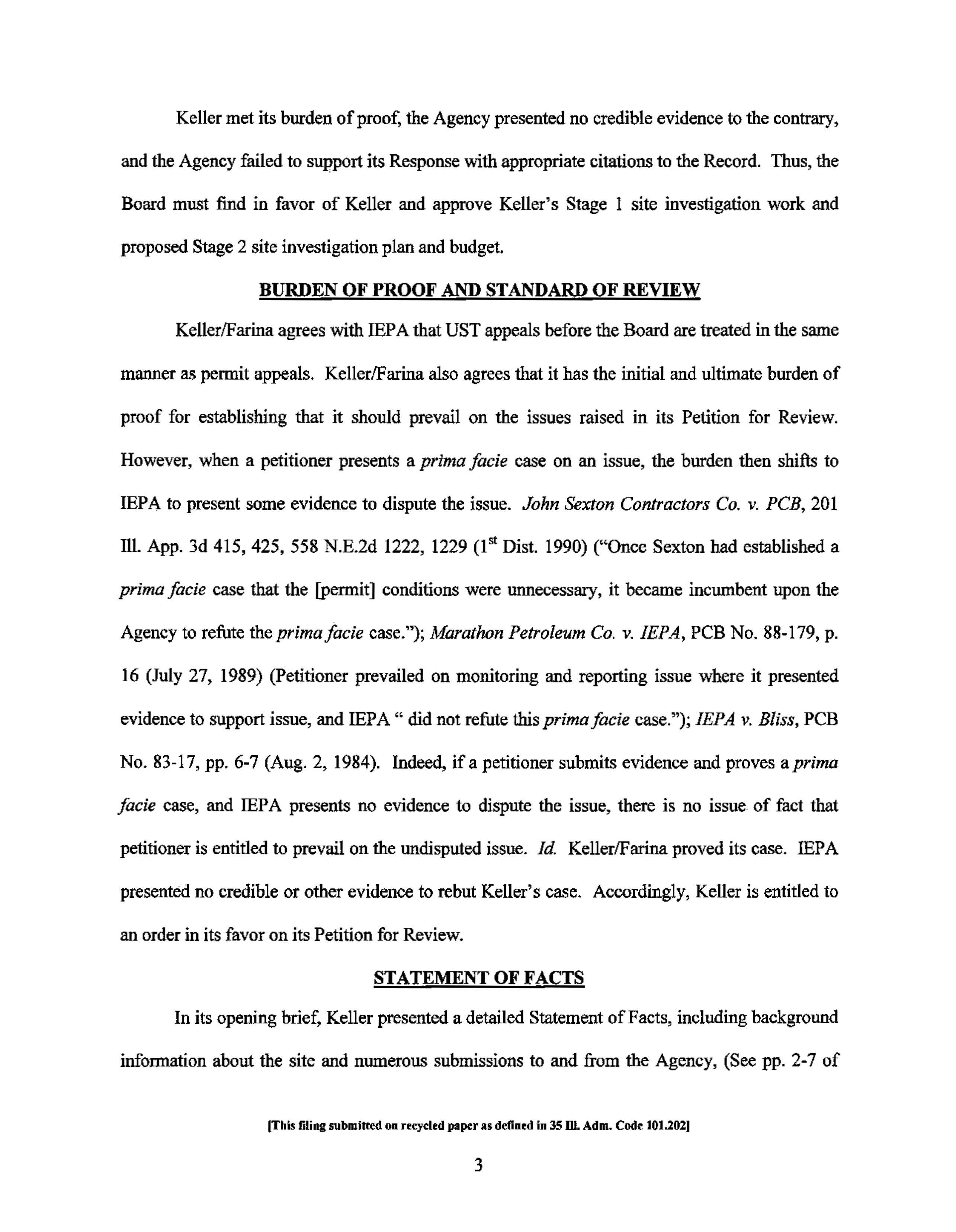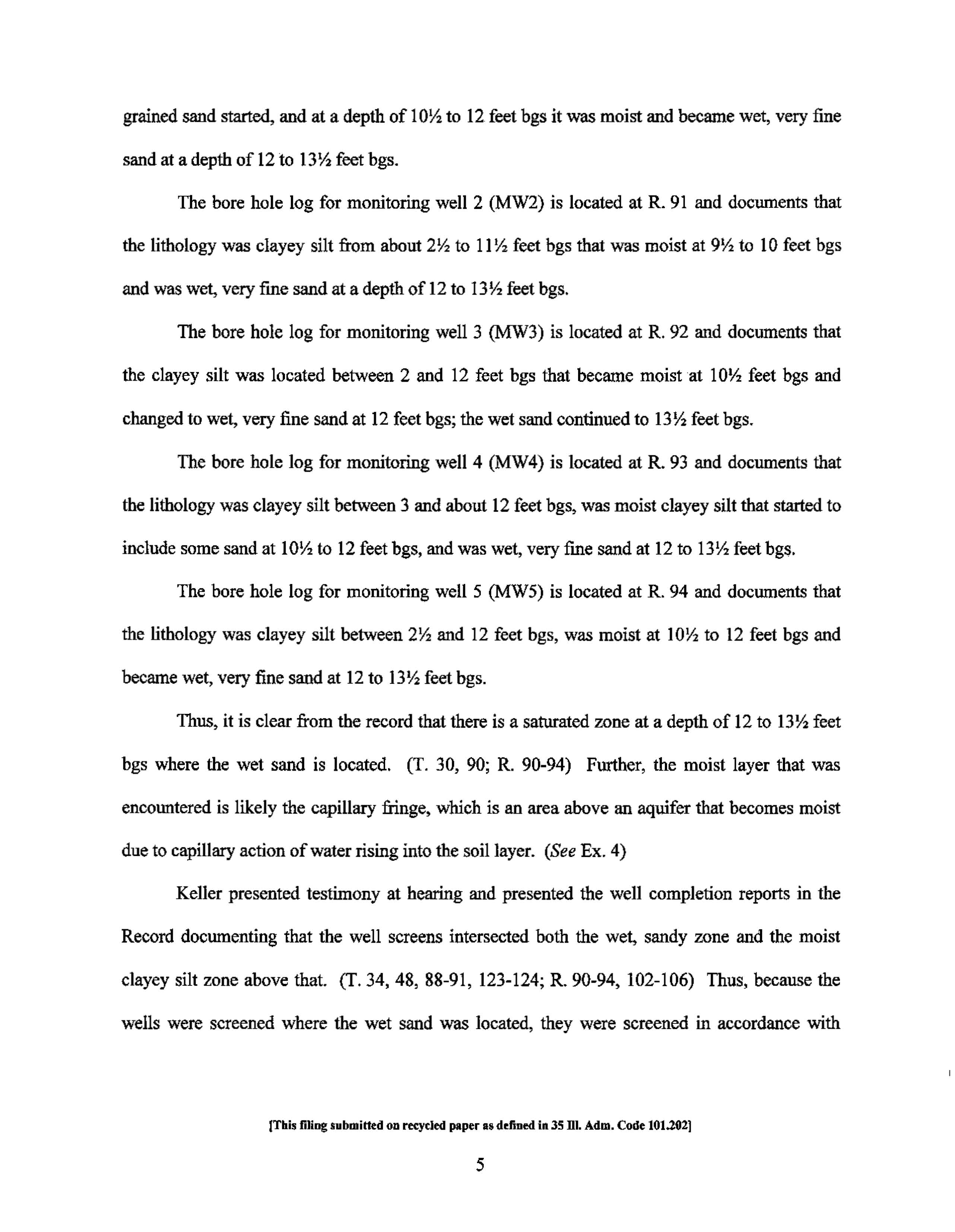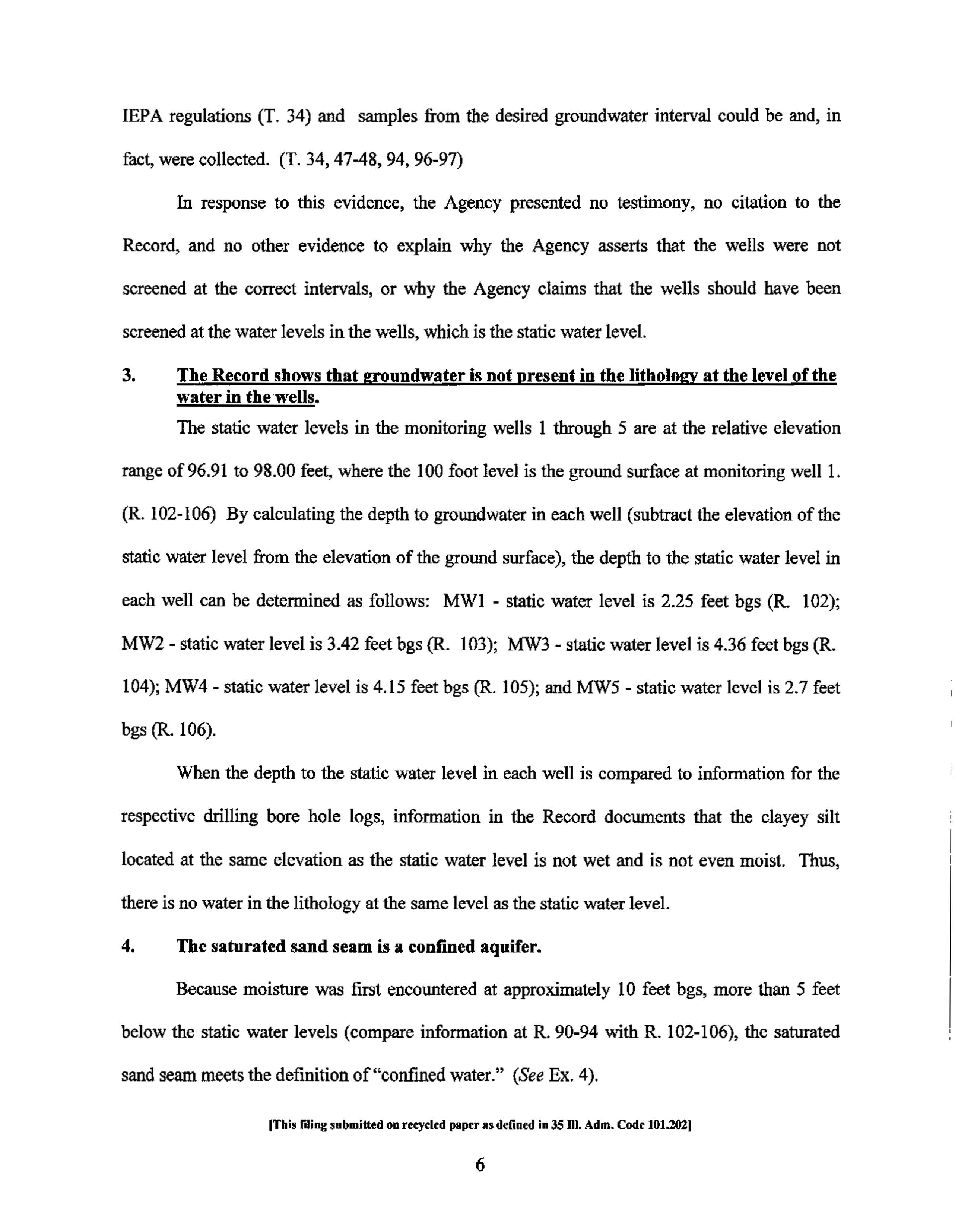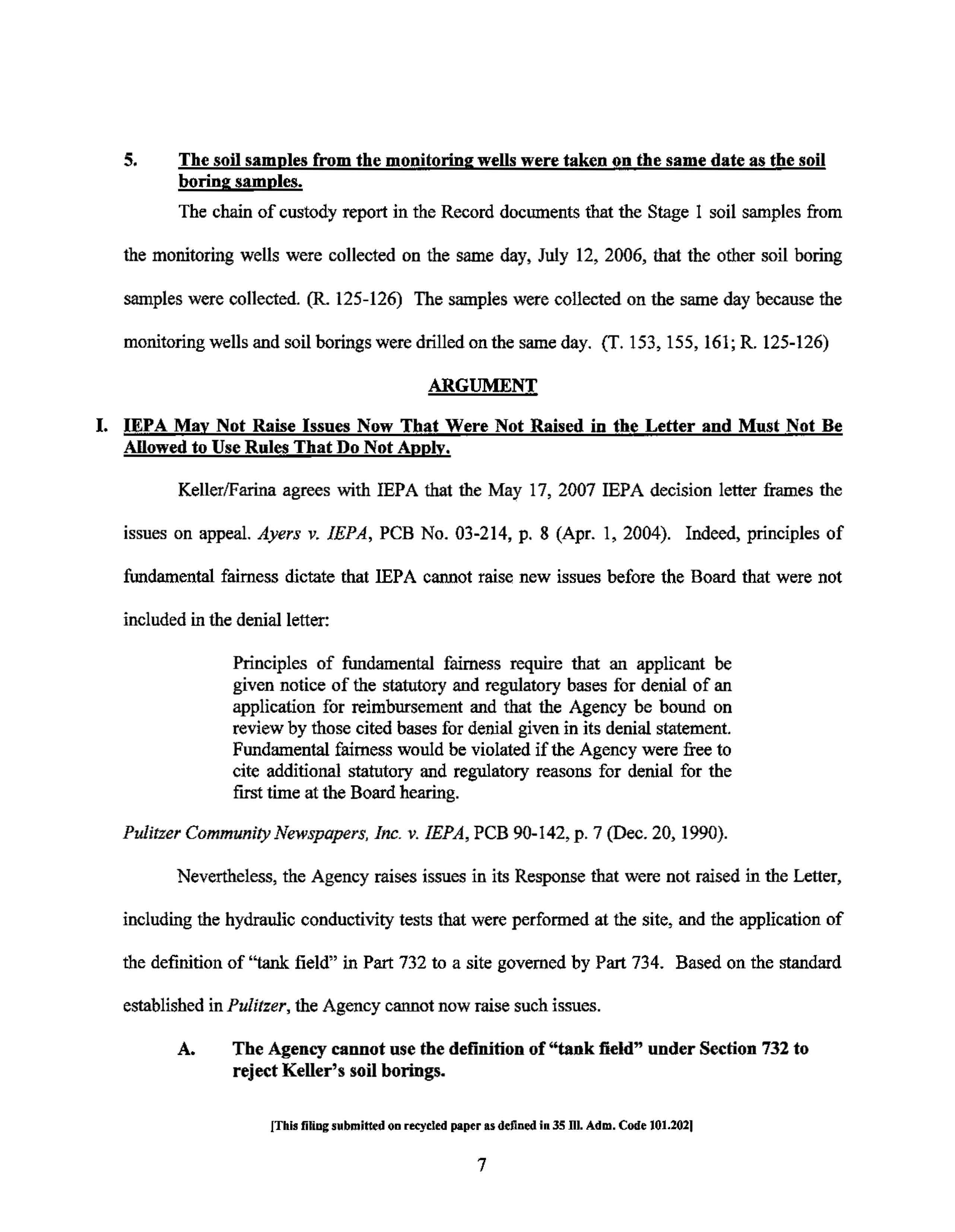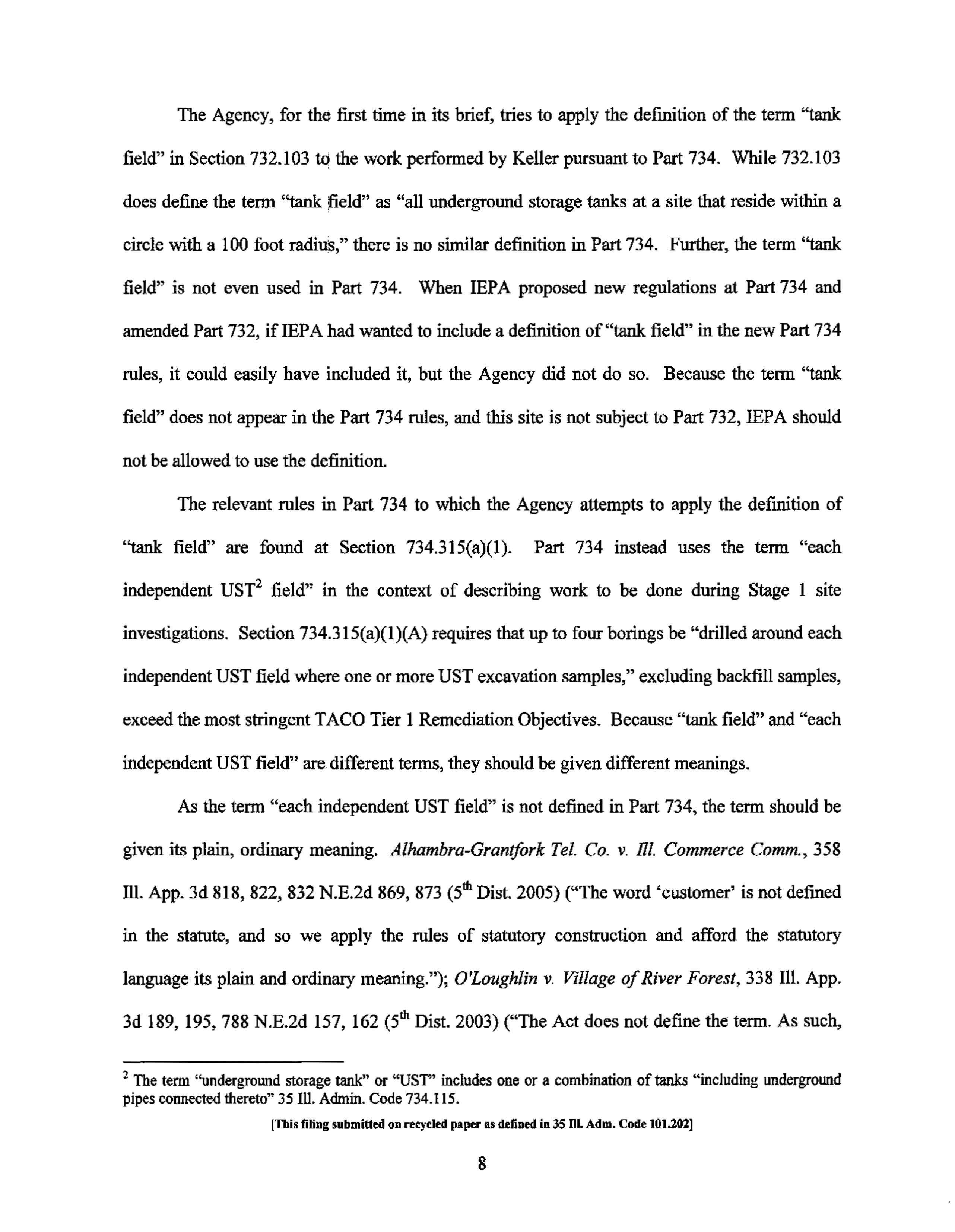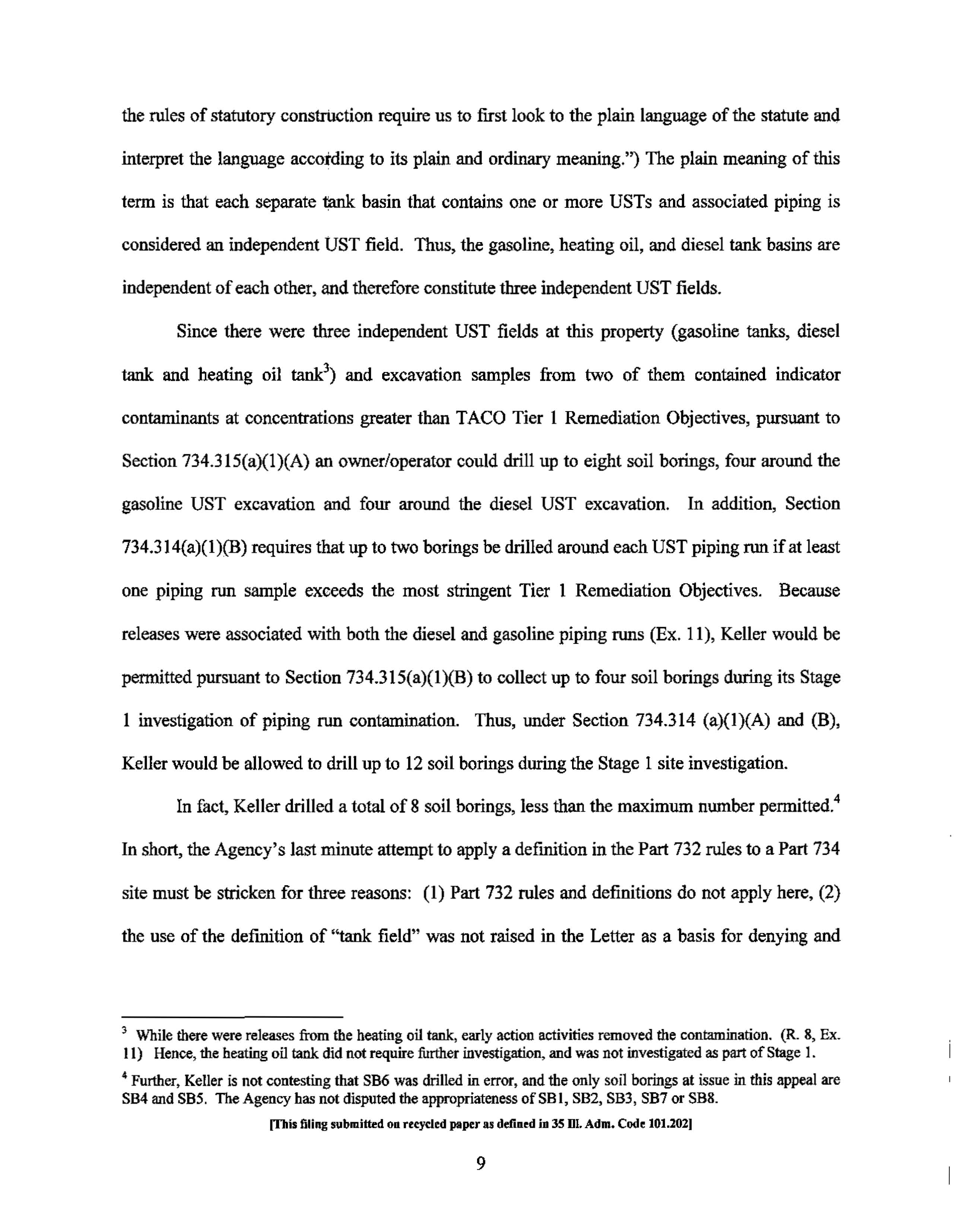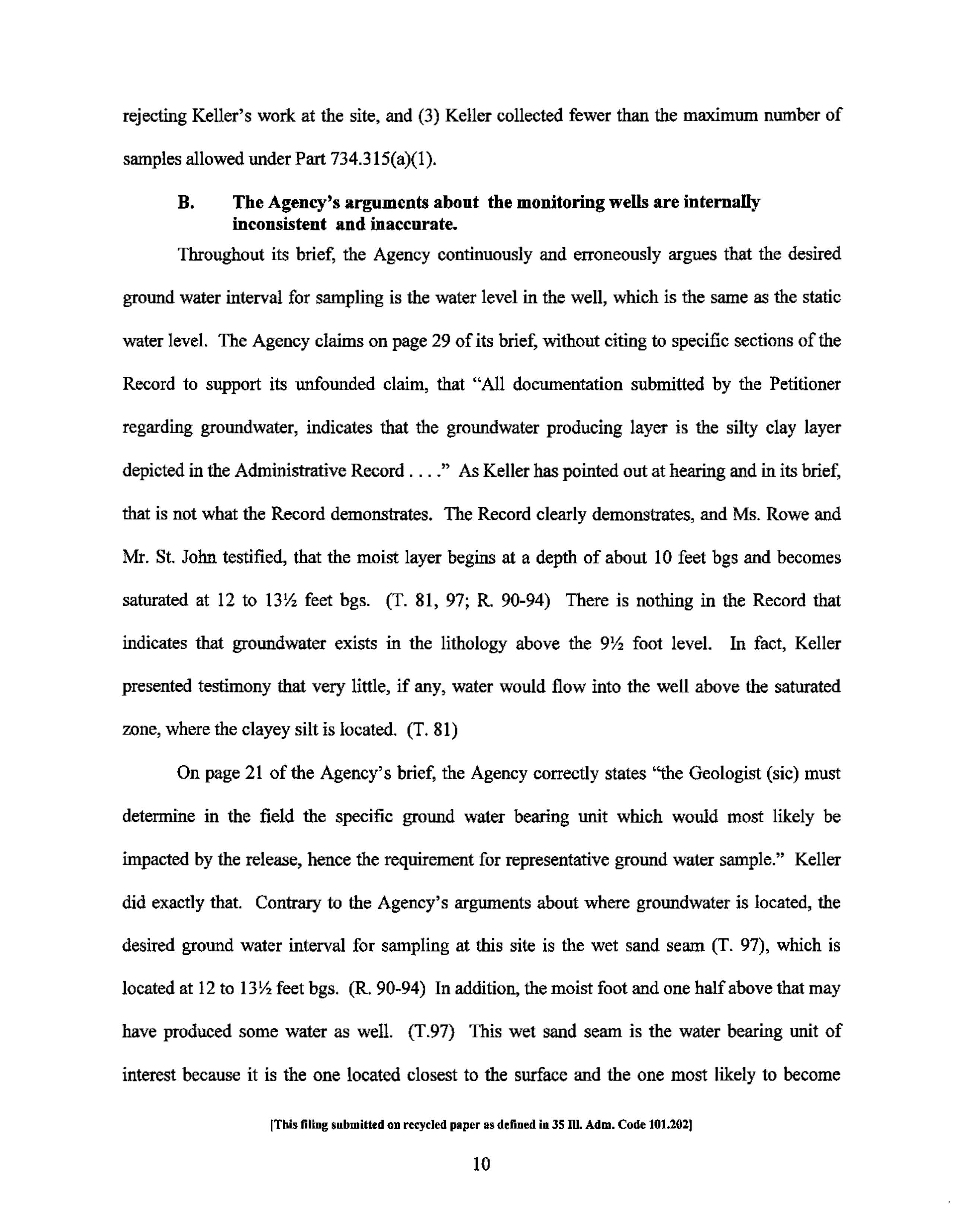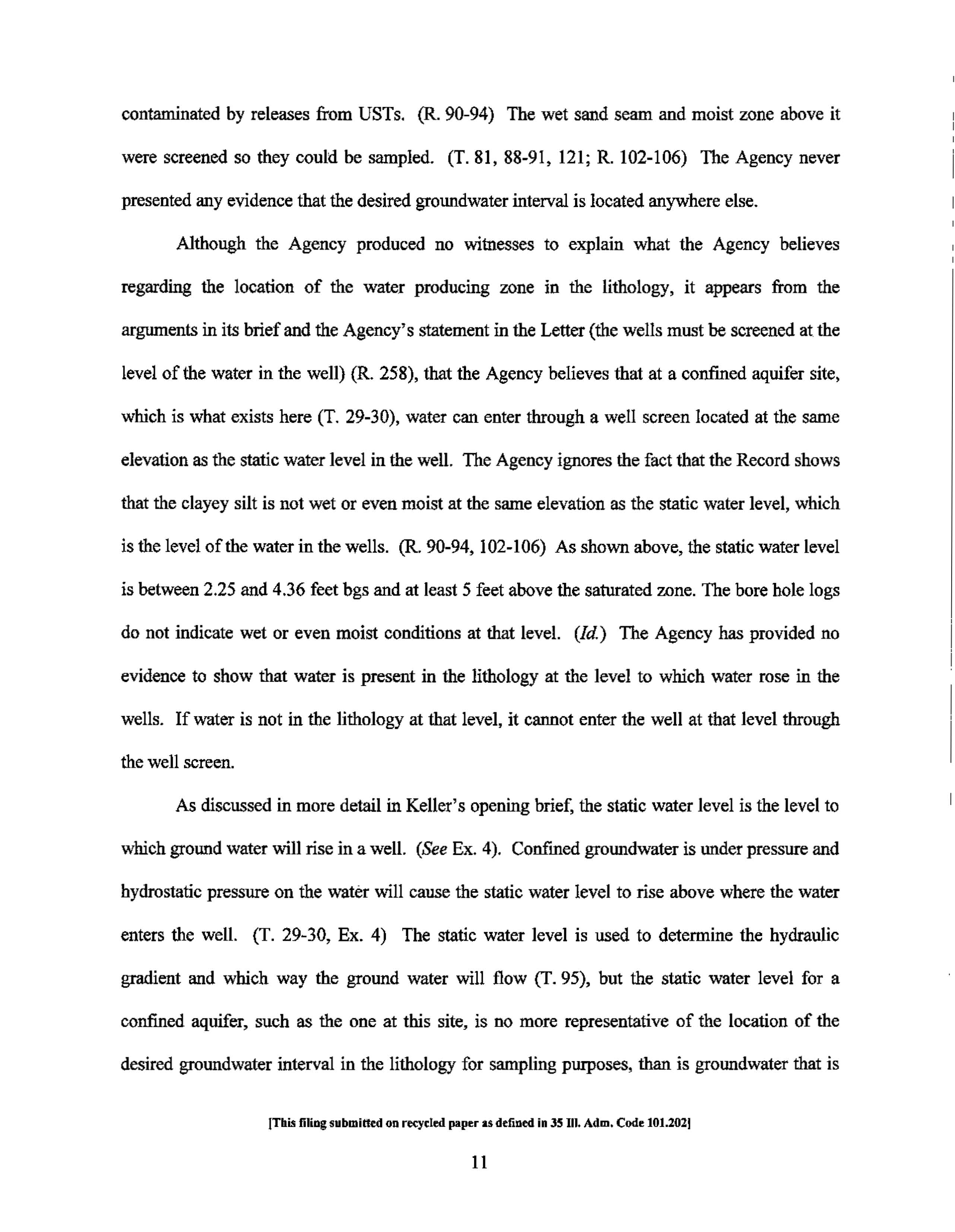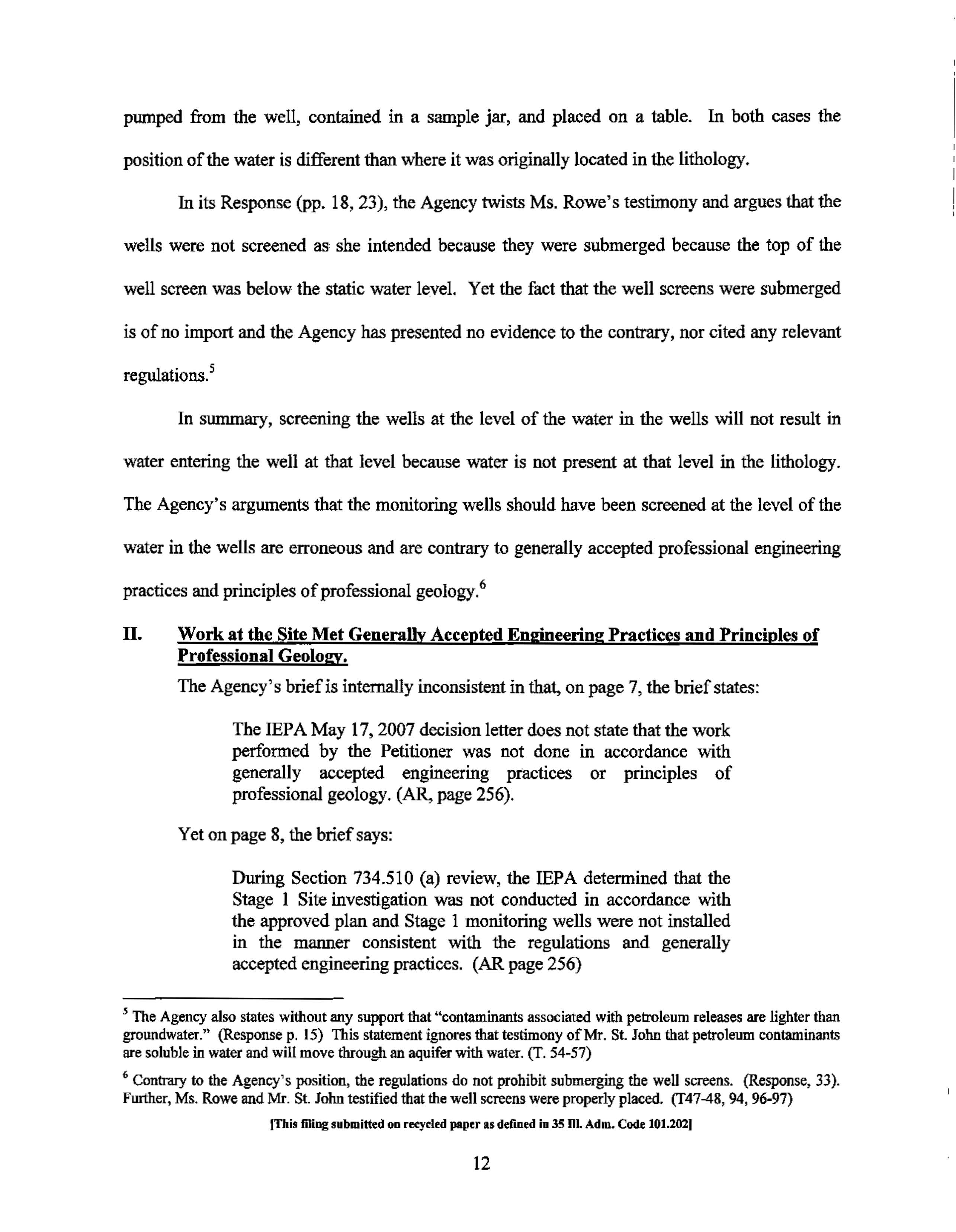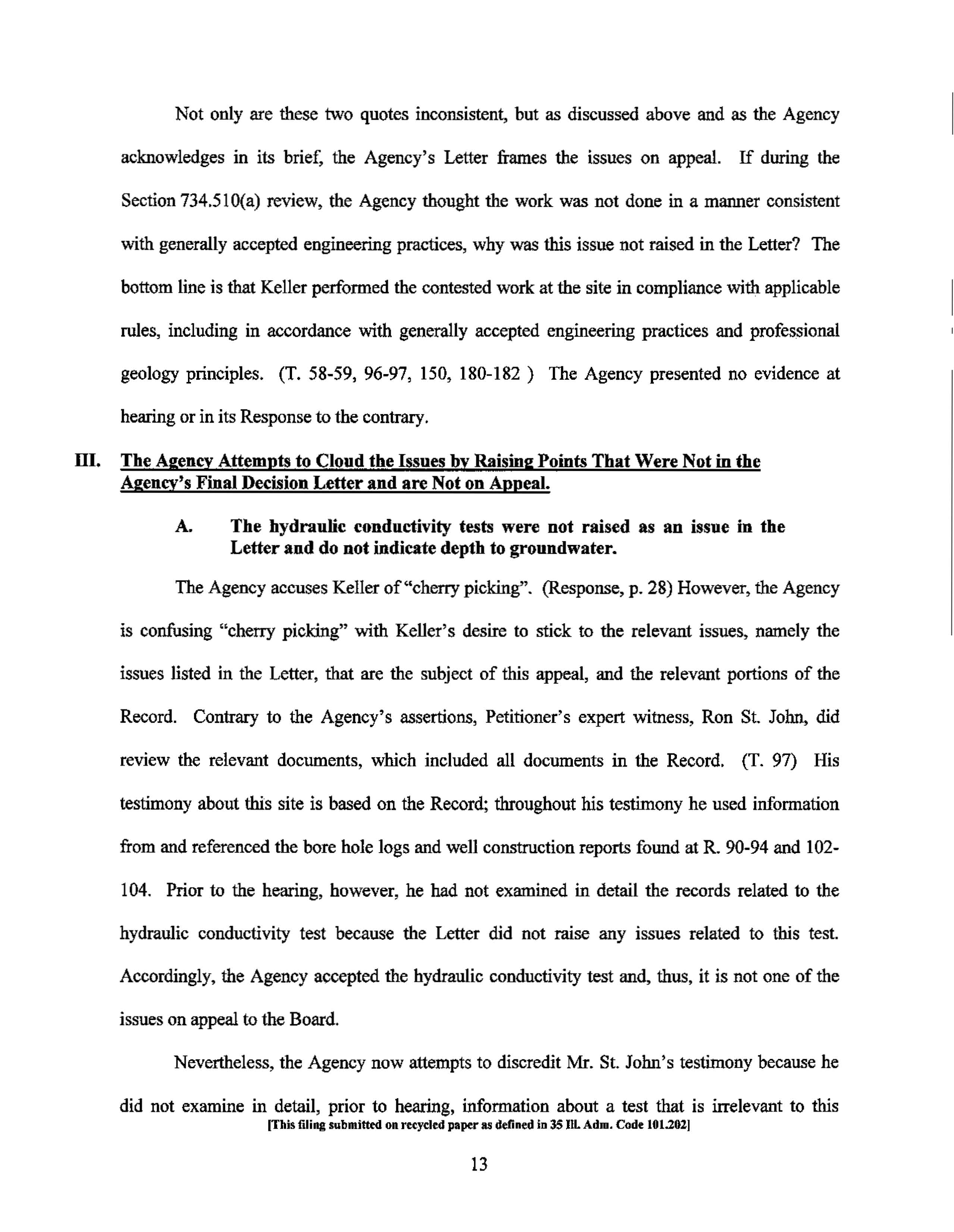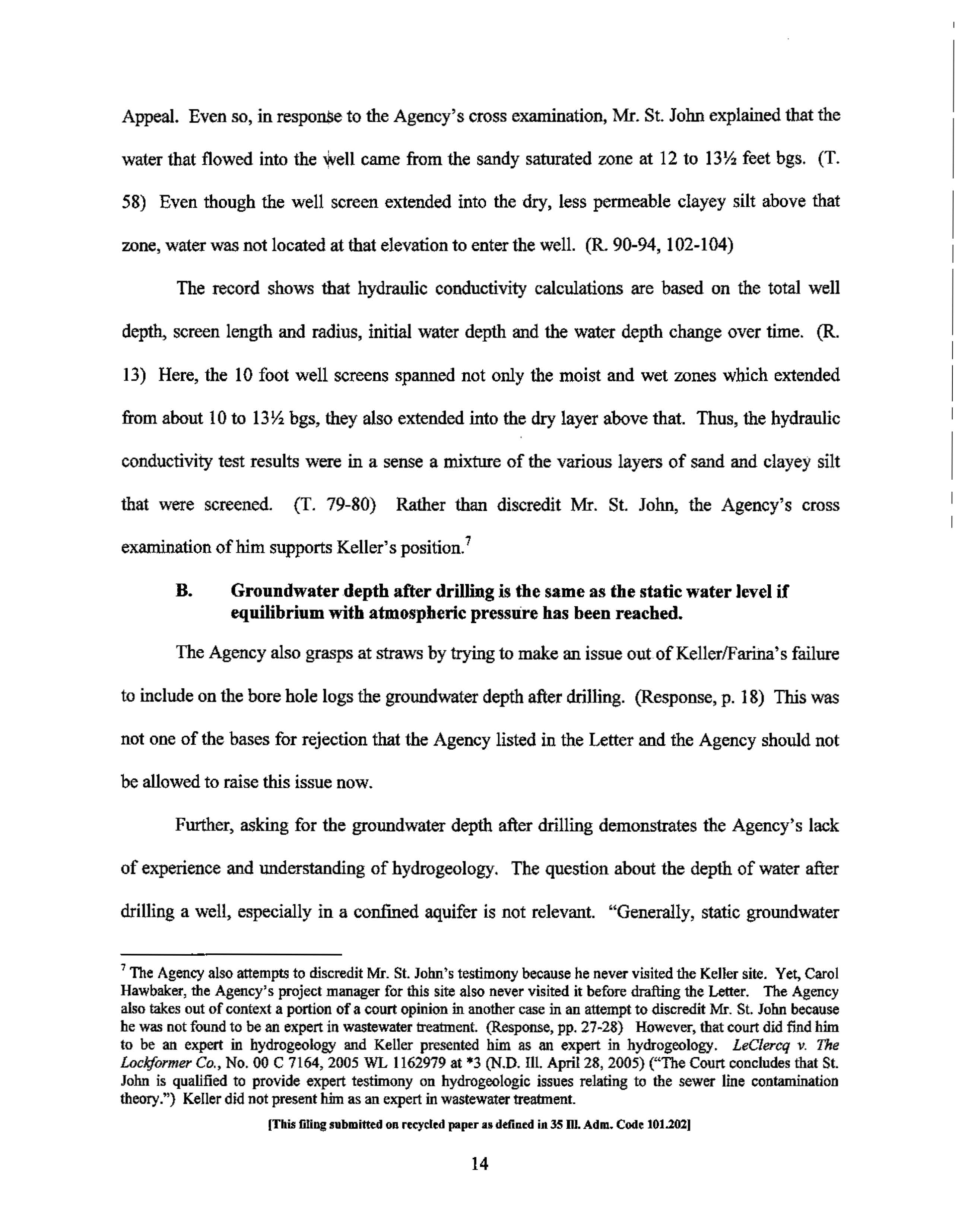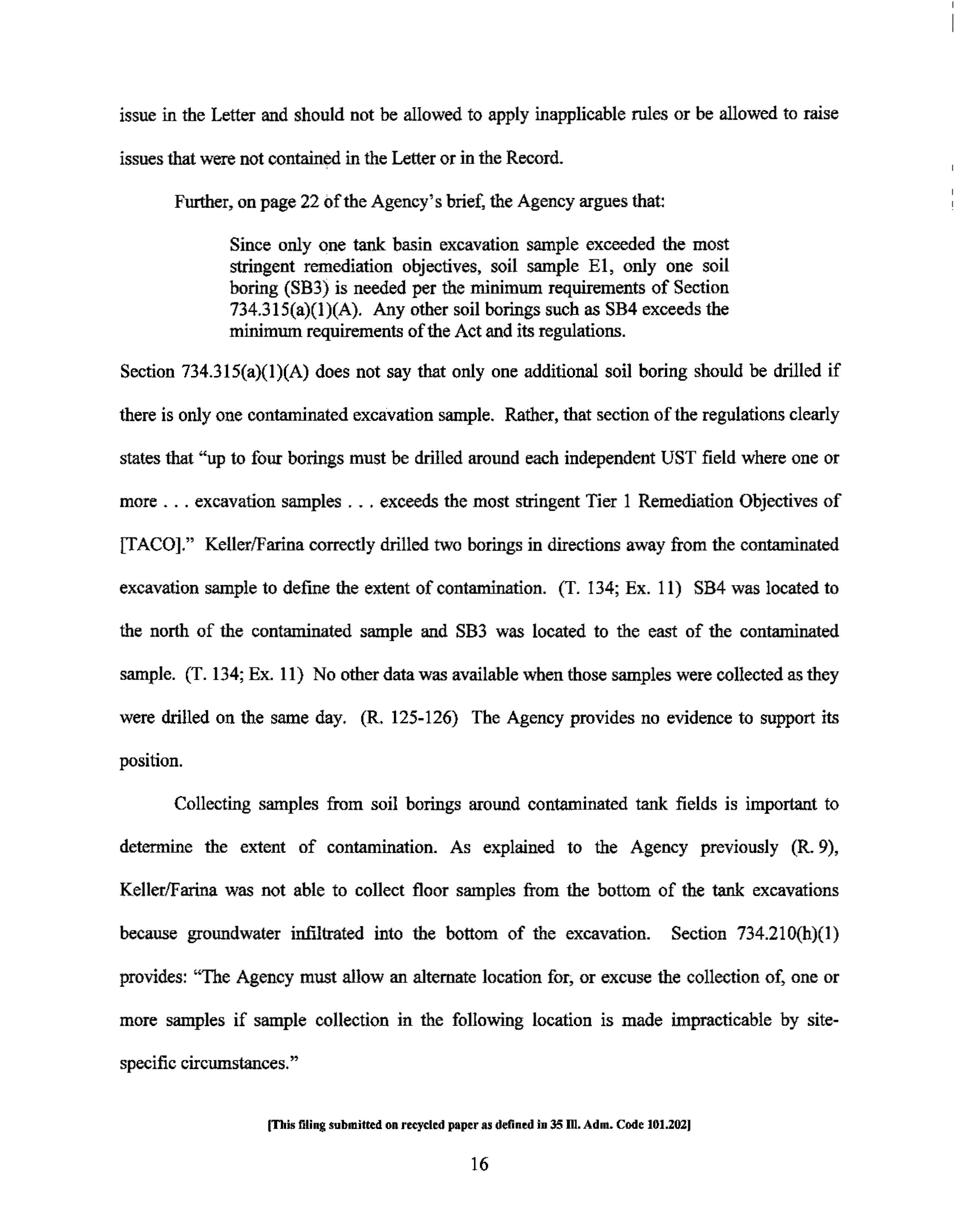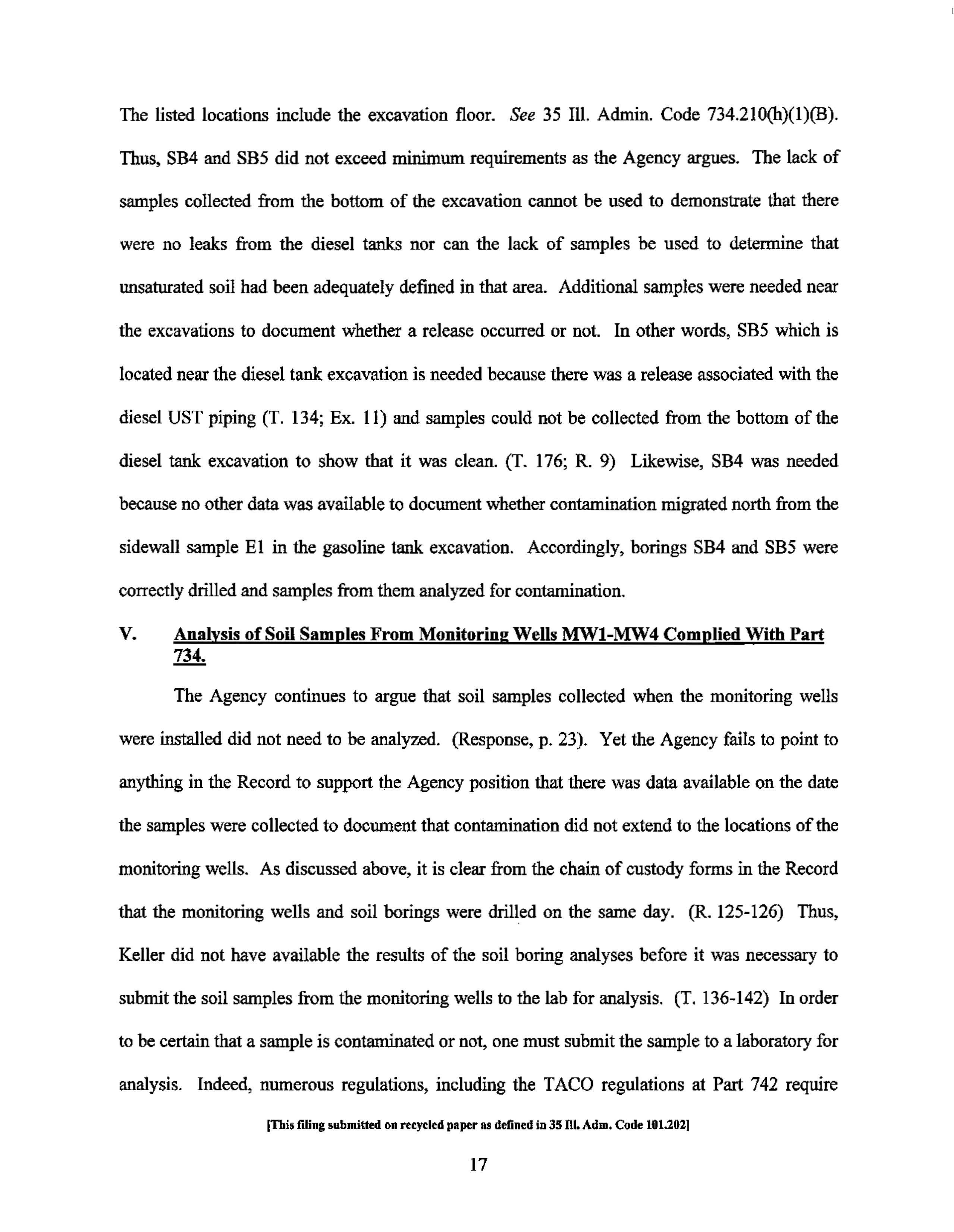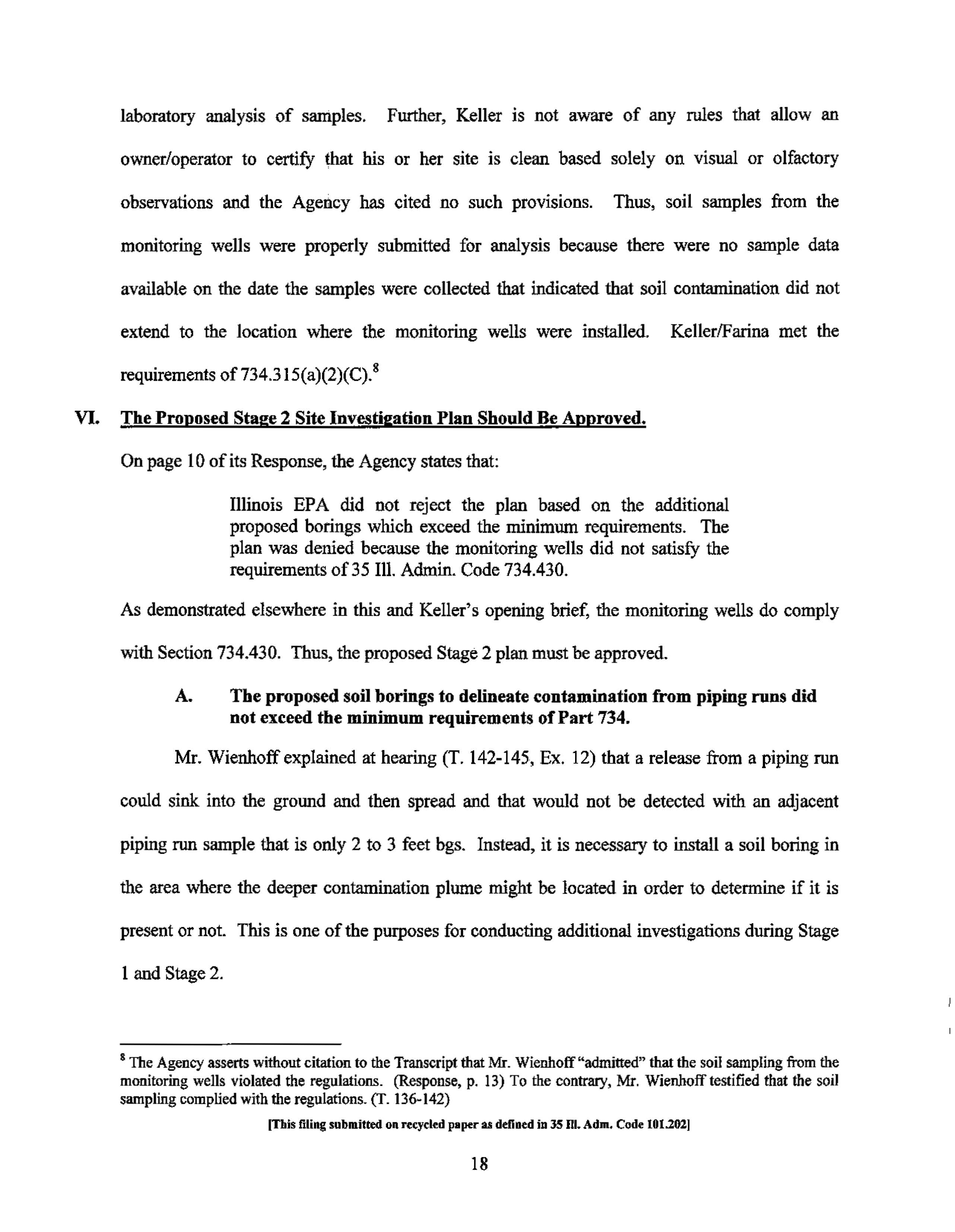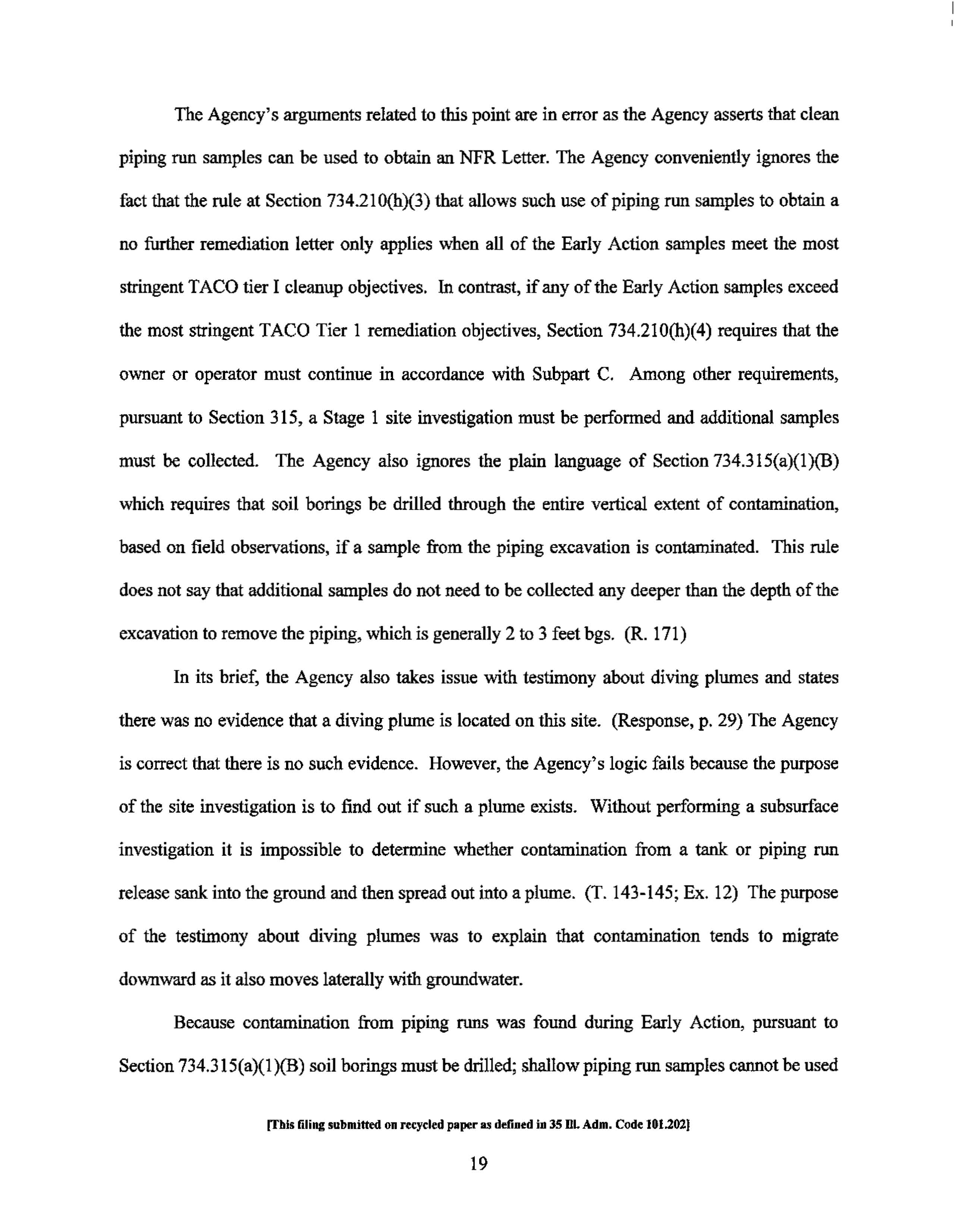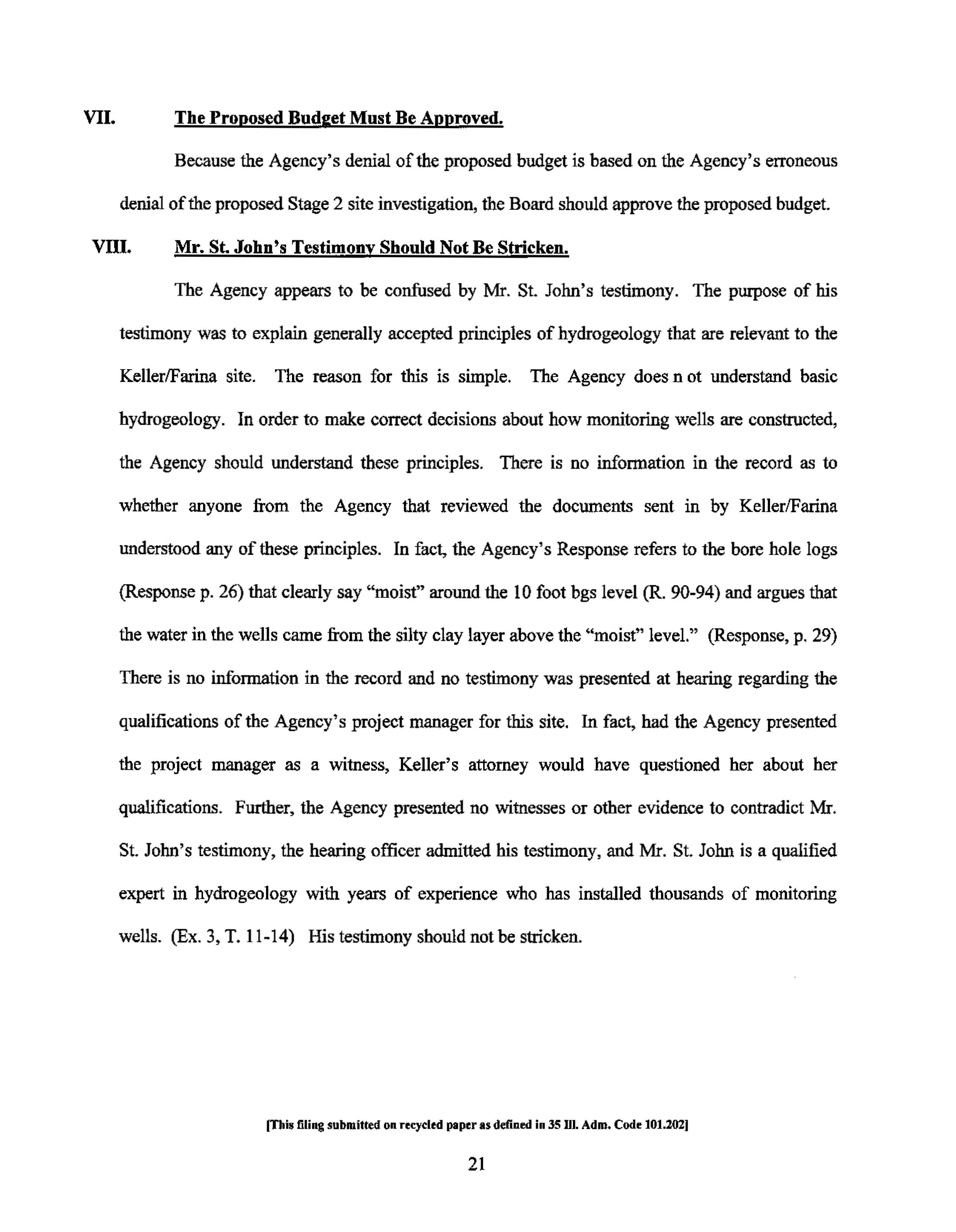BEFORE THE POLLUTION CONTROL BOARD
OF THE STATE OF ILLINOIS
L.
KELLER OIL PROPERTIES, INC. / FARINA
Petitioner,
v.
ILLINOIS ENVIRONMENTAL
PROTECTION AGENCY,
Respondent.
)
)
)
)
) PCB No. 07-147
)
)
)
)
)
NOTICE OF FILING
TO:
Melanie A. Jarvis
Assistant Counsel
Division
of Legal Counsel
Illinois Environmental Protection Agency
1021 North Grand Avenue East
P.O. Box 19276
Springfield, Illinois 62794-9276
Carol Webb
Hearing Officer
Illinois Pollution Control Board
1021 North Grand Avenue East
P.O. Box 19274
Springfield, Illinois 62794-9274
PLEASE
TAKE
NOTICE that on October 22, 2007, there was filed
with
the Clerk of
the Illinois Pollution Control Board of the State of Illinois
an
original, executed copy of
Petitioner's Motion
to
File Post-Hearing Reply Brief and Reply
in
Support of Post-Hearing
Brief.
Dated: October
22,2007
Respectfully submitted,
Carolyn
S. Hesse
Barnes & Thornburg LLP
One North Wacker Drive
Suite 4400
Chicago, lllinois 60606
(312) 357-1313
By:
L. KELLER OIL PROPERTIES
I
FARINA
~jHSi.J.WZ
(This filing submitted on recycled paper as defined in 35 III. Adm. Code 101.2021
Electronic Filing, Received, Clerk's Office, October 22, 2007
BEFORE THE POLLUTION CONTROL BOARD
OF THE STATE OF ILLINOIS
L. KELLER OIL PROPERTIES
I
FARINA
Petitioner,
v.
ILLINOIS ENVIRONMENTAL
PROTECTION AGENCY,
Respondent.
)
)
)
)
) PCB No. 07-147
)
)
)
)
)
MOTION OF PETITIONER
L.
KELLER OIL PROPERTIESIFARINA TO FILE
POST-HEARING REPLY BRIEF
Pursuant to 35 Illinois Administrative Code 101.500(e), Petitioner,
L.
Keller Oil
PropertiesfFarina ("KellerlFarina" or "Keller") by its counsel Barnes
&
Thornburg LLP
hereby moves the Illinois Pollution Control Board (''Board'')for leave to file a Reply
in
Support of its Post-Hearing Brief.
In
support ofthis motion, Keller states as follows:
1.
On June 27, 2007, Keller filed a Petition for Review challenging the
Agency's May 17,2007 letter that rejected a Site Investigation Plan and Budget for work
by Keller related to UST leaks.
2.
On August 22,2007, the Board held a hearing in this appeal.
3.
On September 18, 2007, Keller timely filed its post-hearing brief.
4.
On October 9, 2007, the Illinois Environmental Protection Agency (the
"Agency") filed its Response to
Keller'sPost-Hearing Brief. In its Response, the Agency
raised a number
of issues for the first time, including but not limited to the Agency's
improper application
of a definition from the Part 732 Rules to the site owned by Keller,
which
is regulated under Part 734, not Part 732. The Agency also raised for the first time
in its brief issues that the Agency did not raise in its denial letter, such as an allegation
(This filing submitted on recycled paper as defined in 35 Ill. Adm. Code 101.2021
that certain infonnation is not included on certain fonns. The Agency raises additional
arguments in its brief that Keller had not raised in its post-hearing brief and that the
Agency had not raised previously.
5.
Accordingly, Petitioner, Keller/Farina seeks leave pursuant to 35 Ill.
Admin. Code 101.500(e) to file a Reply in Support
of its Post-Hearing Brief, in order to
address the above narrow issues and to prevent the material prejudice that
will result from
the Agency's misleading submissions.
6.
Attached to this Motion as Exhibit A is a proposed Reply in Support of
the Post-Hearing Briefthat Keller seeks to file.
WHEREFORE, Petitioner
L. Keller Oil PropertieslFarina respectfully requests the
Board grant this Motion for Leave
to
file the attached Reply in Support of Post-Hearing
Brief, and grant all other relief the Board deems fair and just.
Respectfully submitted,
Carolyn
S. Hesse, Esq.
Jonathan P. Froemel, Esq.
David
T. Ballard, Esq.
Barnes
&
Thornburg LLP
One North Wacker Drive
Suite 4400
Chicago, Illinois 60606
(312) 357-1313
CHDSOI CSH4249J7vl
By:
L. Keller
Oil
Properties (Farina)
~~
Pi
c1
e of Its Attorneys
(This filing submitted on recycled paper as defined in 35 Ill. Adm. Code lO1.202J
-2-
Electronic Filing, Received, Clerk's Office, October 22, 2007
EXHIBIT A
Electronic Filing, Received, Clerk's Office, October 22, 2007
BEFORE THE POLLUTION CONTROL BOARD
OF mE STATE OF ILLINOIS
L. KELLER OIL PROPERTIES
IF
ARINA
Petitioner,
v.
ILLINOIS ENVIRONMENTAL
PROTECTION AGENCY,
Respondent.
)
)
)
)
) PCB No. 07-147
)
)
)
)
)
REPLY OF PETITIONER L. KELLER OIL PROPERTIESIFARINA
IN SUPPORT OF POST HEARING BRIEF
Now comes the Petitioner,
L.
Keller Oil PropertieslFarina ("Keller or "KellerlFarina"),
by
its counsel Barnes
&
Thornburg LLP and hereby submits its reply to the Illinois
Environmental Protection Agency's ("IEPA" or the "Agency") Post Hearing
Brief to the Illinois
Pollution Control Board ("Board").
INTRODUCTION
Keller has met its burden of proof that the Stage 1 site investigation and the proposed
Stage 2 site investigation plan and budget comply with applicable regulations and that the
Agency improperly rejected certain aspects
of this work in a final decision letter dated May 17,
2007 (the "Letter").
In sharp contrast, the Agency failed to present any testimony or evidence at
hearing and failed to cite to any portions
ofthe Administrative Record in its Response to support
its decisions contained in the Letter.
For example, the Agency did not provide any witnesses to
explain or other evidence to support its erroneous interpretation
ofwhat the term "desired ground
water interval" means,
or where monitoring wells should be screened.
[Tbis filing submitted on recycled paper as defined in 35 D1. Adm. Code 101.2021
1
Further, the Agency for the first time in its post-hearing brief erroneously attempted to
apply a
definition in the Part 732 regulations
to
this site. However, the site is instead subject to
Part 734.
In addition, the Agency at hearing and in its brief raised new issues that were not
included in the Letter that is the subject
ofthis appeal, such as the hydraulic conductivity test that
was performed at the Keller site. The Agency also ignores information
in the record such as
documentation that the monitoring wells and soil borings were drilled on the same day so that the
data from the soil boring samples were not available to Keller when soil samples from drilling
the monitoring wells had to be submitted for analysis.
See
35 Ill. Admin. Code 734.315(a)
(2)(C). Therefore,
as ofthe date
the soil samples were taken from the monitoring wells, no other
soil sampling indicated the extent
of soil contamination in the location ofthe monitoring well.
Keller contests IEPA's decisions on the following issues: installation
of the monitoring
wells, analysis
of soil samples from monitoring wells MWl through MW4, the drilling of soil
borings SB4 and SB5 and the Agency's rejection
of the proposed Stage 2 site investigation and
budget. Contrary to the Agency's assertions, Keller's monitoring wells were installed
in
accordance with all applicable regulatory requirements, the soil boring samples were drilled in
compliance with Part 734, soil samples that were collected while the monitoring wells were
being installed were correctly submitted for analysis, and the proposed additional Stage 2 site
investigation plan and budget comply with applicable regulations. In the very limited instances
where KellerlFarina recognized that it made an error, Keller corrected the error, and those few
issues are not part
of this appeal to the Board. Even so, the Agency attempts in its brief to use
those errors
to argue that Keller is wrong on all the issues before the Board.
[Tbis filing submitted on recycled paper as defined in 35 Ul Adm. Code 101.2021
2
Keller met its burden of proof, the Agency presented no credible evidence to the contrary,
and the Agency failed to support its Response with appropriate citations to the Record. Thus, the
Board must find
in favor of Keller
and
approve Keller's Stage 1 site investigation work and
proposed Stage 2 site investigation plan and budget.
BURDEN OF PROOF AND STANDARD OF REVIEW
KellerlFarina agrees with IEPA that UST appeals before the Board are treated in the same
manner
as permit appeals. KellerlFarina also agrees that it has the initial and ultimate burden of
proof for establishing that it should prevail on the issues raised in its Petition for Review.
However, when a petitioner presents a
prima facie
case on an issue, the burden then shifts to
IEPA
to
present some evidence to dispute the issue.
John Sexton Contractors Co.
v.
PCB,
201
IlL App. 3d 415, 425, 558 N.E.2d 1222, 1229 (1
st
Dist. 1990) ("Once Sexton had established a
prima facie
case that the [pennit] conditions were unnecessary, it became incumbent upon the
Agency
to refute the
primafacie
case.");
Marathon Petroleum Co.
v.
fEPA,
PCB No. 88-179, p.
16 (July 27, 1989) (Petitioner prevailed on monitoring and reporting issue where it presented
evidence to support issue, and IEPA
" did not refute this
primafacie
case.");
fEPA
v.
Bliss,
PCB
No. 83-17, pp. 6-7 (Aug. 2, 1984). Indeed,
if a petitioner submits evidence and proves a
prima
facie
case, and IEPA presents no evidence to dispute the issue, there is no issue of fact that
petitioner is entitled to prevail on the undisputed issue.
fa.
KellerlFarina proved its case. IEPA
presented no credible or other evidence to rebut Keller's case. Accordingly, Keller is entitled
to
an order in its favor on its Petition for Review.
STATEMENT OF FACTS
In its opening brief, Keller presented a detailed Statement of Facts. including background
information about the site and numerous submissions to and from the Agency, (See pp. 2-7
of
(This filing submitted on recycled paper as defined in 35 Dl Adm. Code 101.2021
3
Keller's Post Hearing Brief) That Statement of Facts will not be repeated in its entirety here.
Rather, KellerlFarina wishes to emphasize the following relevant facts:
1.
Keller presented four Qualified witnesses, while the Agency presented none.
At hearing Keller presented four witnesses, two of whom are professional engineers and
two
of whom are professional geologists. Each of them have had years of experience in
investigating remediation sites. (T.
14, 87, 175; Ex. 3, 7, 10,
13i
Collectively, they have
installed or supervised the installation
ofthousands of monitoring wells.
(Id)
Keller'switnesses
testified that the work that was done at the site complied with applicable Agency rules and
generally accepted professional engineering practices and professional geologist procedures.
(T.58-59, 96-97, 150, 180-182) In sharp contrast, the Agency presented no witnesses or
evidence at hearing to show that the work did not comply with applicable rules, or generally
accepted engineering or geology practices (T. 185-186)
2.
The Record shows the wells were screened at the appropriate interval.
The Administrative Record (the "Record") that was before the Agency shows that the
wells were screened to intersect the desired groundwater interval.
Moisture was first
encountered at approximately
10 feet below ground surface ("bgs''),and between approximately
12 and 1312 feet below ground surface the lithology was wet sand. (T. 90; See bore hole logs for
the monitoring wells at R. 90-94)
Specifically, the bore hole log for monitoring well 1 (MWI) is located at R. 90 and
documents that the lithology was clayey silt between
2~
and about 12 feet bgs, where fine
I
The designation "R." refers to the administrative record in this appeal. The designation "T." refers to the
transcript of the Board hearing that took place
in
this appeal on August 22,2007. The designation "Ex." Refers to
exhibits at the August 22,2007 hearing.
IThis filing submitted on reqcled paper as defined in 35 Ill. Adm. Code 101.202]
4
grained sand started, and at a depth of 1
O~
to 12 feet bgs it was moist and became wet, very fine
sand at a depth
of 12 to 13
~
feet bgs.
The bore hole log for monitoring well 2 (MW2)
is located at R. 91 and documents that
the lithology
was clayey silt from about 2
Y2
to 11
~
feet bgs that was moist at
9~
to 10 feet bgs
and was wet, very fine sand at a depth
of 12 to
13~
feet bgs.
The bore hole log for monitoring well 3 (MW3) is located at
R.
92 and documents that
the clayey silt was located between 2 and
12 feet bgs that became moist at 1
O~
feet bgs and
changed to wet, very fine sand at
12 feet bgs; the wet sand continued to
13~
feet bgs.
The bore hole log for monitoring well 4 (MW4) is located at
R.
93 and documents that
the lithology
was clayey silt between 3 and about 12 feet bgs, was moist clayey silt that started to
include some sand at
10~
to 12 feet bgs, and was wet, very fine sand at 12 to
13~
feet bgs.
The bore hole log for monitoring well 5 (MW5)
is located at R. 94 and documents that
the lithology was clayey silt between
2Y:z and 12 feet bgs, was moist at
1O~
to
12 feet bgs and
became wet, very fine sand at
12 to 13
~
feet bgs.
Thus, it
is clear from the record that there is a saturated zone at a depth of 12 to BY; feet
bgs where the wet sand is located. (T. 30, 90;
R. 90-94) Further, the moist layer that was
encountered is likely the capillary fringe, which is an
area above an aquifer that becomes moist
due
to
capillary action of water rising into the soil layer.
(See
Ex. 4)
Keller presented testimony at hearing and presented the well completion reports in the
Record documenting that the well screens intersected both the wet, sandy zone and the moist
clayey silt zone above that.
(T. 34, 48, 88-91, 123-124; R.90-94, 102-106) Thus, because the
wells were screened where the wet sand was located, they were screened in accordance with
rrbls filing submitted on recycled paper as defined in 35 III. Adm. Code 101.202]
5
IEPA regulations (T. 34) and samples from the desired groundwater interval could be and,
in
fact, were collected. (T. 34,47-48,94,96-97)
In response to this evidence, the Agency presented no testimony, no citation to the
Record, and no other evidence to explain why the Agency asserts that the wells were not
screened at the correct intervals,
or why the Agency claims that the wells should have been
screened at the water levels in the wells, which is the static water level.
3.
The Record shows that groundwater is not present in the lithology at the level of the
water in the wells.
The static water levels in the monitoring wells 1 through 5 are at the relative elevation
range of96.91 to 98.00 feet, where the 100 foot level is the ground surface at monitoring well I.
(R.I02-106) By calculating the depth to groundwater
in
each well (subtract the elevation of the
static water level from the elevation
of the ground surface), the depth to the static water level in
each well can be determined as follows:
MWI - static water level is 2.25 feet bgs (R. 102);
MW2 - static water level is 3.42 feet bgs (R. 103); MW3 - static water level is 4.36 feet bgs (R.
104); MW4 - static water level is 4.15 feet bgs (R. 105); and MW5 - static water level is 2.7 feet
bgs (R. 106).
When the depth to the static water level in each well is compared to information for the
respective drilling bore hole logs, information in the Record documents that the clayey silt
located at the same elevation as the static water level is not
wet and is not even moist. Thus,
there is no water
in
the lithology at the same level as the static water level.
4.
The saturated sand seam is a confined aquifer.
Because moisture was fIrst encountered at approximately 10 feet bgs, more than 5 feet
below the static water levels (compare information at R. 90-94 with R. 102-106), the saturated
sand seam meets the definition
of "confined water."
(See
Ex. 4).
(This filing submitted on reqtled paper as defined in 35 01. Adm. Code 101.202)
6
5.
The soil samples from the monitoring wells were taken on the same date as the soil
boring samples.
The chain of custody report in the Record documents that the Stage 1 soil samples from
the monitoring wells were collected on the same day, July 12, 2006, that the other soil boring
samples were collected. (R. 125-126) The samples were collected
on the same day because the
monitoring wells and soil borings were drilled on the same day. (T. 153, 155, 161; R. 125-126)
ARGUMENT
I. IEPA May Not Raise Issues Now That Were Not Raised
in
the Letter and Must Not Be
Allowed to Use Rules That Do Not Apply.
KellerlFarina agrees with IEPA that the May 17, 2007 IEPA decision letter frames the
issues on appeal.
Ayers
v.
IEPA,
PCB No. 03-214, p. 8 (Apr. 1, 2004). Indeed, principles of
fundamental fairness dictate that IEPA cannot raise new issues before the Board that were not
included in the denial letter:
Principles
of fundamental fairness require that an applicant be
given notice
of the statutory and regulatory bases for denial of an
application for reimbursement and that the Agency be bound on
review
by those cited bases for denial given
in
its denial statement.
Fundamental fairness would be violated
if the Agency were free to
cite additional statutory and regulatory reasons for denial for the
first time at the Board hearing.
Pulitzer Community Newspapers, Inc.
v.
IEPA,
PCB 90-142, p. 7 (Dec. 20, 1990).
Nevertheless, the Agency raises issues
in
its Response that were not raised
in
the Letter,
including the hydraulic conductivity tests that were performed at the site, and the application
of
the definition of "tank field"
in
Part 732 to a site governed by Part 734. Based on the standard
established in
Pulitzer,
the Agency cannot now raise such issues.
A.
The Agency cannot use the definition of "tank field" under Section 732 to
reject Keller's soil borings.
ITbis filing submitted on recycled paper as defined in 35 Dl Adm. Code 101.2021
7
The Agency, for the first time
in
its brief, tries to apply the defInition of the term "tank
field" in Section 732.103 to the work performed by Keller pursuant to Part 734. While 732.103
does define the term "tank: field" as
..allunderground storage tanks at a site that reside within a
circle with a 100 foot radius," there is no similar definition
in
Part 734. Further, the tenn
'~
field" is not even used in Part 734. When IEPA proposed new regulations at Part 734 and
amended Part 732,
if IEPA had wanted to include a definition of"tank field" in the new Part 734
rules, it could easily have included it, but the Agency did not do so. Because the term "tank
field" does not appear
in the Part 734 rules, and this site is not subject to Part 732, IEPA should
not
be allowed to use the definition.
The relevant rules in Part 734 to which the Agency attempts to apply the definition of
.'tank. field" are found at Section 734.315(a)(I). Part 734 instead uses the term "each
independent UST
2
field" in the context of describing work to
be
done during Stage 1 site
investigations. Section 734.315(a)(1)(A) requires that up to four borings
be
.'drilledaround each
independent UST field where one or more UST excavation samples," excluding
backfIll samples,
exceed the most stringent TACO Tier 1 Remediation Objectives. Because
''tank
field" and "each
independent UST field" are different terms, they should be given different meanings.
As the term "each independent UST field" is not defined in Part 734, the term should be
given its
plai~
ordinary meaning.
Alhambra-Grant/ark Tel. Co.
v.
Rl. Commerce Comm., 358
Ill. App. 3d 818, 822, 832 N.E.2d 869,
873 (5
th
Dist. 2005) ("The word 'customer'is not defined
in the statute, and so we apply the rules of statutory construction and afford the statutory
language its plain and ordinary meaning.");
O'Loughlin
v.
Village ofRiver Forest,
338 Ill. App.
3d 189, 195, 788 N.E.2d 157, 162
(5
th
Dist. 2003) ("The Act does not define the term. As such,
2
The
tenn
"underground storage tank" or "UST" includes one or a combination of tanks "including undergrOlDld
pipes connected thereto" 35 Ill. Achnin. Code 734.115.
[This filing submined on recycled paper as defined in 3S OJ. Adm. Code 101.202]
8
the rules of statutory construction require us to frrst look to the plain language of the statute and
interpret the language according to its plain and ordinary meaning.") The plain meaning
of this
tenn is that each separate
tank
basin that contains one or more USTs and associated piping is
considered an independent UST field. Thus, the gasoline, heating oil, and diesel
tank basins are
independent
of each other, and therefore constitute
three
independent UST fields.
Since there were three independent UST fields at this property (gasoline
tanks, diesel
tank
and heating oil
tank
3
)
and excavation samples from two of them contained indicator
contaminants at concentrations greater than TACO Tier 1 Remediation Objectives, pursuant to
Section 734.315(a)(l )(A) an owner/operator could drill up to eight soil borings, four around the
gasoline UST excavation and four around the diesel UST excavation. In addition, Section
734.314(a)(I)(B) requires that up to two borings be drilled around each UST piping
run ifat least
one piping
run sample exceeds the most stringent Tier 1 Remediation Objectives. Because
releases were associated with both the diesel and gasoline piping runs (Ex. 11), Keller would be
pennitted pursuant to Section 734.315(a)(I)(B) to collect up to four soil borings during its Stage
1 investigation
of piping run contamination. Thus, under Section 734.314 (a)(l)(A) and (B),
Keller would be allowed to drill up to 12 soil borings during the Stage 1 site investigation.
In fact, Keller drilled a total
of 8 soil borings, less than the maximum number pennitted.
4
In
short, the Agency's last minute attempt to apply a definition in the Part 732 rules to a Part 734
site must be stricken for three reasons: (1) Part 732 rules and definitions do not apply here, (2)
the use
of the definition of "tank field" was not raised in the Letter as a basis for denying and
3 While there were releases from the heating oil tank, early action activities removed the contamination. (R. 8, Ex.
11) Hence, the heating oil tank did not require further investigation, and was not investigated as part
ofStage I.
4 Further, Keller is not contesting that SB6 was drilled in error, and the only soil borings at issue in this appeal are
SB4 and SB5. The Agency has not disputed the appropriateness
ofSBI, SB2, SB3, SB7 or SB8.
(This filing submitted on recycled paper as defined in 35 U1. Adm. Code 101.2021
9
rejecting Keller's work at the site, and (3) Keller collected fewer than the maximwn number of
samples allowed under Part 734.315(a)(I).
B.
The Agency's arguments about the monitoring weDs are internally
inconsistent and inaccurate.
Throughout its brief, the Agency continuously and erroneously argues that the desired
ground water interval for sampling is the water level in the
well, which is the same as the static
water leveL The Agency claims on page
29
of its brief, without citing to specific sections of the
Record to support its unfounded claim, that "All documentation submitted
by the Petitioner
regarding groundwater, indicates that the groundwater producing layer is the silty clay layer
depicted in the Administrative Record
...." As Keller
has
pointed out at hearing and in its brief,
that is not what the Record demonstrates. The Record clearly demonstrates, and Ms. Rowe and
Mr. St. John testified, that the moist layer begins at a depth
of about 10 feet bgs and becomes
saturated at
12 to
13~
feet bgs. (T. 81, 97; R. 90-94) There is nothing in the Record that
indicates that groundwater exists in the lithology above the
9~
foot level.
In
fact, Keller
presented testimony that very little,
if any, water would flow into the well above the saturated
zone, where the clayey silt is located. (T. 81)
On page 21 of the Agency's brief, the Agency correctly states "the Geologist (sic) must
determine in the field the specific ground water bearing unit which would most likely be
impacted by the release, hence the requirement for representative ground water sample." Keller
did exactly that. Contrary to the Agency's arguments about where groundwater is located, the
desired ground water interval for sampling at this site is the
wet sand seam (T. 97), which is
located at
12 to
13~
feet bgs. (R. 90-94) In addition, the moist foot and one half above that may
have produced some water as well. (T.97) This wet sand seam is the water bearing
unit of
interest because it is the one located closest to the surface and the one most likely to become
[fbis filing submitted on recycled paper as defiDed in 35 IU. Adm. Code 101.2021
10
contaminated by releases from USTs. (R.90-94) The wet sand seam and moist zone above it
were screened so they could be sampled.
(T. 81, 88-91, 121; R. 102-106) The Agency never
presented any evidence that the desired groundwater interval is located anywhere else.
Although the Agency produced no witnesses to explain what the Agency believes
regarding the location
of the water producing zone in the lithology, it appears from the
argwnents
in
its briefand the Agency's statement
in
the Letter (the wells must be screened at the
level
of the water in the well) (R. 258), that the Agency believes that at a confined aquifer site,
which is what exists here (T. 29-30), water can enter through a well screen located at the same
elevation
as the static water level in the well. The Agency ignores the fact that the Record shows
that the clayey silt is not wet or even moist at the same elevation as the static water level, which
is the level
of the water in the wells. (R. 90-94, 102-106) As shown above, the static water level
is between 2.25 and 4.36 feet bgs and at least 5 feet above the saturated zone. The bore hole logs
do not indicate wet or even moist conditions at that level.
(ld.)
The Agency has provided no
evidence to show that water is present
in
the lithology at the level
to
which water rose in the
wells.
If water is not
in
the lithology at that level, it cannot enter the well at that level through
the well screen.
As discussed in more detail in Keller's opening brief, the static water level is the level to
which ground water will rise
in
a well.
(See
Ex. 4). Confined groundwater is under pressure and
hydrostatic pressure on the
water will cause the static water level to rise above where the water
enters the well. (T. 29-30, Ex. 4) The static water level is used to determine the hydraulic
gradient and which way the ground water will flow
(T. 95), but the static water level for a
confined aquifer, such as the one at this site, is no more representative
of the location of the
desired groundwater interval
in
the lithology for sampling purposes, than is groundwater that is
(This filing submitted on recycled paper as defined in 3S D1. Adm. Code 101.2021
11
pumped from the well, contained in a sample jar; and placed on a table. In both cases the
position
ofthe water is different than where it was originally located in the lithology.
In its Response (pp. 18,23), the Agency twists Ms. Rowe'stestimony and argues that the
wells were not screened as she intended because they were submerged because the top
of the
well screen was below the static water level. Yet the fact that the well screens were submerged
is
of no import and the Agency has presented no evidence to the contrary. nor cited any relevant
regulations.
5
In summary. screening the wells at the level of the water in the wells will not result in
water entering the well at that level because water is not present at that level
in
the lithology.
The Agency's arguments that the monitoring wells should have been screened at the level
of the
water
in
the wells are erroneous and are contrary to generally accepted professional engineering
practices and principles
ofprofessional geology.
6
II.
Work at the Site Met Generally Accepted Engineering Practices and Principles of
Professional Geology.
The Agency's brief is internally inconsistent in that, on page 7, the briefstates:
The IEPA May 17, 2007 decision letter does not state that the work
performed by the Petitioner was not done
in
accordance with
generally accepted engineering practices or principles
of
professional geology. (AR, page 256).
Yet
on page 8, the briefsays:
During Section 734.510 (a) review, the IEPA determined that the
Stage 1 Site investigation was not conducted
in
accordance with
the approved plan and Stage 1 monitoring wells were not installed
in the manner consistent with the regulations and generally
accepted engineering practices. (AR page 256)
5 The Agency also states without any support that "contaminants associated with petroleum releases are lighter than
groundwater." (Response p. 15) This statement ignores that testimony of Mr. St. John that petroleum contaminants
are soluble in water and will move through an aquifer with water. (T. 54-57)
6 Contrary to the Agency's position, the regulations do not prohibit submerging the well screens. (Response, 33).
Further, Ms. Rowe and Mr. St. John testified that the well screens were
propei"ly placed. (f4748, 94, 96-97)
[This filing submitted on recycled paper as defined in 35 1lI. Adm. Code 101.2021
12
Not only are these two quotes inconsistent, but as discussed above and as the Agency
acknowledges
in its brief, the Agency's Letter frames the issues on appeal. lf during the
Section 734.510(a) review, the Agency thought the work was not done in a manner consistent
with generally accepted engineering practices, why was this issue not raised in the Letter? The
bottom line is that Keller performed the contested work at the site
in compliance with applicable
rules, including in accordance with generally accepted engineering practices and professional
geology principles. (T. 58-59, 96-97, 150,
180-182) The Agency presented no evidence at
hearing
or
in
its Response to the contrary.
III. The Agency Attempts to Cloud the Issues by Raising Points That Were Not in the
Agency's Final Decision Letter and
are Not on Appeal
A.
The hydraulic conductivity tests were not raised as an issue
in
the
Letter
and do not indicate depth to groundwater.
The Agency accuses Keller of "cherry picking". (Response, p. 28) However, the Agency
is confusing "cherry picking" with Keller's desire to stick
to the relevant issues, namely the
issues listed
in
the Letter, that are the subject of this appeal, and the relevant portions of the
Record. Contrary to the Agency's assertions, Petitioner's expert witness,
Ron St. John, did
review the relevant documents, which included all documents
in
the Record. (T. 97) His
testimony about this site is based
on the Record; throughout his testimony he used information
from and referenced the bore hole logs and well construction reports found at R. 90-94 and 102-
104. Prior
to
the hearing, however, he had not examined
in
detail the records related to the
hydraulic conductivity test because the Letter did
not raise any issues related to this test.
Accordingly, the Agency accepted the hydraulic conductivity test and, thus,
it is not one of the
issues on appeal to the Board.
Nevertheless, the Agency now attempts to discredit Mr. St. John's testimony because
he
did not examine
in
detail, prior to hearing, information about a test that is irrelevant to this
[Tbis filiDg submitted OD recycled paper 85 defined in 35 01. Adm. Code 101.2021
13
Appeal. Even so, in response
to
the Agency'scross examination, Mr. 81. John explained that the
water that flowed into the well came from the sandy saturated zone at 12 to
131h feet bgs. (T.
58) Even though the well screen extended into the dry, less permeable clayey silt above that
zone, water
was
not located at that elevation to enter the well. (R. 90-94, 102-104)
The record shows that hydraulic conductivity calculations are based
on the total well
depth, screen length and radius, initial water depth and the water depth change over time. (R.
13) Here, the 10 foot well screens spanned not only the moist and wet zones which extended
from about 10 to
131Jz bgs, they also extended into the dry layer above that. Thus, the hydraulic
conductivity test results were
in a sense a mixture of the various layers of sand and clayey silt
that were screened. (T.
79-80) Rather than discredit Mr. 81. John, the Agency's cross
examination
ofrum supports Keller's position.
7
B.
Groundwater depth after drilling is the same as the static water level if
equilibrium with atmospheric pressure has been reached.
The Agency also grasps at straws by trying to make an issue out ofKeller/Farina'sfailure
to
include on the bore hole logs the groundwater depth after drilling. (Response, p. 18) This was
not one
of the bases for rejection that the Agency listed in the Letter and the Agency should not
be allowed to raise this issue now.
Further, asking for the groundwater depth after drilling demonstrates the Agency's lack
of experience and understanding of hydrogeology. The question about the depth of water after
drilling a well, especially in a confined aquifer is not relevant. "Generally, static groundwater
7 The Agency also attempts to discredit
Mr.
St. John'stestimony because he never visited the Keller site. Yet, Carol
Hawbaker, the
Agency's project manager for this site also never visited it before drafting the Letter. The Agency
also takes out
of context a portion of a court opinion
in
another case
in
an attempt to discredit
Mr.
St. John because
he
was not found to be an expert in wastewater treatment. (Response, pp. 27-28) However, that court did fmd him
to be an expert
in
hydrogeology and Keller presented him as an expert
in
hydrogeology.
LeClercq
v.
The
Lockformer Co.,
No. 00 C 7164, 2005 WL 1162979 at *3 (N.D. Ill. April 28, 2005) ("The Court concludes that St.
John is qualified
to provide expert testimony on hydrogeologic issues relating to the sewer line contamination
theory.") Keller did
not present him as an expert
in
wastewater treatment.
[Tbis filing submitted on recycled paper as defined in 35 m. Adm. Code 101.2021
14
elevations do not stabilize on the date of well installation and well development procedures
interfere
with determination of static elevation." (T. 32-33; R. 11) In a confined aquifer, such
as the one at the Keller site. after a well is installed and developed, water will continue
to slowly
rise in the well until eventually the static water level is reached. Typically, well development
involves causing water levels to fluctuate by surging and removing water from the well
to
remove fIne grained material that gets smeared down to the level of the saturated zone. (T. 35,
92) In other words, in a confined aquifer and depending on site-specifIc lithology and soil
penneability, there will likely
be differences in the water level in the well immediately after the
well is drilled and developed, one hour later, two hours later, and
fIve hours later as the water
continues
to rise until the hydrostatic pressure on the water equilibrates with atmospheric
pressure,
in
other words, when the static water level is reached. There is nothing
in
the Record
and the Agency presents no evidence
to
support why a separate entry for depth
to
groundwater
after drilling is significant or why that value differs from the static water level after equilibrium
is reached. Further, the Agency did not raise this issue in the Letter and should be precluded
from raising it now.
IV. Soil Borings SB4
and SB5 Complied With Part 734.
In
its opening brief, Keller provided detailed arguments and cites
to
the Record and
applicable regulations that the soil borings that the Agency objected to, SB4 and SB5, were
drilled
in
compliance with applicable regulations.
Keller will not repeat those detailed
arguments here. As discussed above, rather than point to evidence in the Record or present
witnesses at hearing to explain its position, the Agency
in
it briefargues for the first time that the
definition for
''tankfIeld"
in
Part 732 applies
to
a Part 734 site. The Agency did not raise this
IThis filing submitted on recycled paper as defined in 35 m. Adm. Code 101.2021
15
issue in the Letter and should not be allowed to apply inapplicable rules or be allowed to raise
issues that were not contained in the Letter or
in
the Record.
Further, on page 22 of the Agency'sbrief, the Agency argues that:
Since only one
tank. basin excavation sample exceeded the most
stringent remediation objectives, soil sample
El, only one soil
boring (SB3) is needed per the minimum. requirements
of Section
734.315(a)(1)(A). Any other soil borings such as SB4 exceeds the
minimum requirements
ofthe Act and its regulations.
Section 734.315(a)(1)(A) does not say that only one additional soil boring should be drilled
if
there is only one contaminated excavation sample. Rather, that section ofthe regulations clearly
states that
"up to four borings must be drilled around each independent UST field where one or
more ... excavation samples ... exceeds the most stringent Tier 1 Remediation Objectives of
[TACO]." Keller/Farina correctly drilled two borings in directions away from the contaminated
excavation sample
to
defIne the extent of contamination. (T. 134; Ex. 11) SB4 was located
to
the north of the contaminated sample and SB3 was located to the east of the contaminated
sample. (T. 134; Ex. 11)
No other data was available when those samples were collected as they
were drilled
on the same day. (R. 125-126) The Agency provides no evidence to support its
position.
Collecting samples from soil borings around contaminated
tank
fields is important to
determine the extent
of contamination. As explained to the Agency previously (R. 9),
KellerlFarina was not able to collect floor samples from the bottom
of the
tank
excavations
because groundwater infiltrated into the bottom
of the excavation. Section 734.21O(h)(1)
provides: "The Agency
must allow an alternate location for, or excuse the collection of, one or
more samples if sample collection in the following location is made impracticable by site-
specifIc circumstances."
(Tbisfiliog submitted on recycled paper
u
defined in 35 m. Adm. Code 101.202)
16
The listed locations include the excavation floor.
See
35 Ill. Admin. Code 734.210(h)(I)(B).
Thus, SB4 and SB5 did not exceed minimum requirements as the Agency argues. The lack of
samples collected from the bottom of the excavation cannot be used to demonstrate that there
were no leaks from the diesel tanks nor can the lack of samples be used to determine that
unsaturated soil
had
been adequately defined in that area. Additional samples were needed near
the excavations to document whether a release occurred or not. In other words, SB5 which is
located near the diesel tank excavation is needed because there was a release associated with the
diesel UST piping (T. 134; Ex. 11) and samples could not be collected from the bottom
of the
diesel
tank
excavation to show that it was clean. (T. 176; R. 9) Likewise. SB4 was needed
because no other data was available to document whether contamination migrated north from the
sidewall sample E1
in
the gasoline tank excavation. Accordingly. borings SB4 and SB5 were
correctly drilled and samples from them analyzed for contamination.
V.
Analysis of Soil Samples From Monitoring Wells MWI-MW4 Complied With Part
734.
The Agency continues to argue that soil samples collected when the monitoring wells
were installed did not need to be analyzed. (Response, p. 23). Yet the Agency fails to point to
anything in the Record to support the Agency position that there
was
data available on the date
the samples were collected to document that contamination did not extend to the locations
of the
monitoring wells.
As discussed above, it is clear from the chain of custody forms in the Record
that the monitoring wells and soil borings were drilled on the same day. (R. 125-126) Thus,
Keller did not have available the results
of the soil boring analyses before it was necessary to
submit the soil samples from the monitoring wells to the lab for analysis. (T. 136-142) In order
to be certain that a sample is contaminated
or not. one must submit the sample to a laboratory for
analysis. Indeed, numerous regulations. including the TACO regulations at Part 742 require
[Thb filing sublDitted on recycled paper as defined in 35 III. AdlD. Code 101.202]
17
laboratory analysis of samples. Further, Keller is not aware of any rules that allow an
owner/operator to certify that his or her site is clean based solely
on visual or olfactory
observations and the Agency
has
cited no such provisions. Thus, soil samples from the
monitoring wells were properly submitted for analysis because there were no sample data
available on the date the samples were collected that indicated that soil contamination did not
extend to the location where the monitoring wells were installed. KellerlFarina met the
requirements
of 734.315(a)(2)(C).8
VI. The Proposed Stage 2 Site Investigation Plan Should Be Approved.
On page 10 of its Response, the Agency states that:
Illinois
EPA did not reject the plan based on the additional
proposed borings which exceed the minimum requirements. The
plan
was denied because the monitoring wells did not satisfy the
requirements
of 35 111. Admin. Code 734.430.
As demonstrated elsewhere in this and Keller's opening brief, the monitoring wells do comply
with
Section 734.430. Thus, the proposed Stage 2 plan must be approved.
A.
The proposed soil borings to delineate contamination from piping runs did
not exceed
the minimum requirements of Part 734.
Mr. Wienhoff explained at hearing (T. 142-145, Ex. 12) that a release from a piping run
could sink into the ground and then spread and that would not be detected with an adjacent
piping run sample that is only 2 to 3 feet bgs. Instead, it is necessary
to
install a soil boring
in
the area where the deeper contamination plume might be located in order
to
detennine if it is
present
or not. This is one of the pmposes for conducting additional investigations during Stage
1 and Stage 2.
8 The Agency asserts without citation to the Transcript that
Mr.
Wienhoff"admitted" that the soil sampling from the
monitoring wells violated the regulations. (Response, p. 13) To the contrary,
Mr.
Wienhofftestified that the soil
sampling complied with the regulations. (T. 136.142)
(This filing submitted on recycled paper liS defined in 35 ilL Adm. Code 101.2021
18
The Agency's arguments related to this point are
in
error as the Agency asserts that clean
piping run samples can be used to obtain an
NFR Letter. The Agency conveniently ignores the
fact that the rule at Section 734.210(h)(3) that allows such use of piping run samples to obtain a
no further remediation letter only applies when all of the Early Action samples meet the most
stringent TACO tier I cleanup objectives.
In
contrast, if any of the Early Action samples exceed
the most stringent TACO Tier 1 remediation objectives, Section 734.210(h)(4) requires that the
owner
or operator must continue in accordance with Subpart C. Among other requirements,
pursuant to Section 315, a Stage 1 site investigation must be performed and additional samples
must be collected. The Agency also ignores the plain language
of Section 734.315(a)(I)(B)
which requires that soil borings be drilled through the entire vertical extent
of contamination,
based on field observations,
if a sample from the piping excavation is contaminated. This rule
does not say that additional samples do not need to be collected any deeper than the depth
of the
excavation to remove the piping, which is generally 2
to 3 feet bgs. (R. 171)
In its brief, the Agency also takes issue with testimony about diving phunes and states
there was no evidence that a diving plume is located on this site. (Response, p. 29) The Agency
is correct
that there is no such evidence. However, the Agency'slogic fails because the purpose
of the site investigation is to fmd out if such a plume exists. Without performing a subsurface
investigation it is impossible to determine whether contamination from a
tank
or piping run
release sank into the ground and then spread out into a plume. (T. 143-145; Ex. 12) The purpose
of the testimony about diving plumes was to explain that contamination tends to migrate
downward as it also moves laterally
with groundwater.
Because contamination from piping runs was found during Early Action, pursuant to
Section 734.315(a)(1)(B) soil borings must be drilled; shallow piping run samples cannot be used
IThis filiog submitted 00 rttytled paper as defined in 3S D1. Adm. Code 101.2(2)
19
to detennine if contamination exists throughout the entire vadose zone. Without installing soil
borings at greater depths than piping run samples, a site owner/operator will have no way
of
knowing whether a diving plume exists or not. The only way to know if one exists is to conduct
the Stage 1 and Stage 2 investigations ancl.
to
sample in areas where a diving plume would most
likely be located.
B.
Proposed soil samples between the gasoline pump island and MW2 do not
exceed the minimum requirements of
Part 734.
On page 25 of its brief, the Agency takes issue with the proposed soil samples to be
located between the pump island and MW2. As KellerlFarina argued before, it appears
to
KellerlFarina's consultant that the contamination at monitoring well 2 might meet Tier 2
Remediation Objectives after additional
data is collected and the appropriate calculations are
made to determine Tier 2 Remediation Objectives. (T. 147-150) Accordingly, the purpose of
collecting samples between the pump island and monitoring well 2 is to begin
to
delineate the
area that will likely exceed Tier 2 Remediation Objectives because those are the remediation
objectives that are generally needed to meet the minimum requirements
of the Act.
(Id)
Such
samples can either be collected as part
of the Stage 2 Site Investigation when the consultant will
be at the site to collect the Stage 2 samples, or the consultant can make a separate trip to the site
at some point in the future when the Agency asks the consultant
to
perform further delineation of
the contamination in order to reduce the size of the area that must be remediated. Since in all
likelihood the samples will need
to
be collected at some point in the future, it makes more sense
and it is more cost effective to collect the samples as part of the Stage 2 Site Investigation.
(Id)
Accordingly, the proposed samples should be approved.
[Tbis filing submitted on recycled paper as defined in 3501. Adm. Code 101.202]
20
VII.
The Proposed Budget Must Be Approved.
Because the Agency'sdenial of the proposed budget is based on the Agency's erroneous
denial
ofthe proposed Stage 2 site investigation, the Board should approve the proposed budget.
VIII.
Mr. St. John'sTestimony Should Not Be Stricken.
The Agency appears to be confused by Mr. St. Jolm's testimony. The purpose of his
testimony was to explain generally accepted principles of hydrogeology that are relevant
to
the
KellerlFarina site. The reason for this is simple. The Agency does n ot understand basic
hydrogeology. In order
to make correct decisions about how monitoring wells are constructed,
the Agency should understand these principles. There is no information in the record as to
whether anyone from the Agency that reviewed the documents sent in by KellerlFarina
understood any
of these principles.
In
fact, the Agency's Response refers to the bore hole logs
(Response p. 26) that clearly say "moist" around the 10 foot bgs level (R. 90-94) and argues that
the water
in
the wells came from the silty clay layer above the "moist" level." (Response, p. 29)
There is no information
in the record and no testimony was presented at hearing regarding the
qualifications
of the Agency's project manager for this site. In fact,
had
the Agency presented
the project manager as a witness, Keller's attorney would have questioned her about her
qualifications. Further, the Agency presented no witnesses
or other evidence to contradict Mr.
St. John's testimony, the hearing officer admitted his testimony, and Mr. St. Jolm is a qualified
expert
in
hydrogeology with years of experience who has installed thousands of monitoring
wells. (Ex. 3,
T. 11-14) His testimony should not be stricken.
(This filiog submitted OD rtcyclcd paper as defilled in 35 III. Adm. Code 101.202]
21
CONCLUSION
Keller met its burden of proofthat the work performed at the site that is the subject of this
appeal complied with applicable laws and regulations. The Agency presented no credible
evidence to the contrary. Accordingly, the Board must
find in favor of Keller/Farina and against
the Agency and award Keller its attorney'sfees and costs.
Respectfully submitted,
L. Keller
Oil Properties (Farina)
By:
~'-"'~
One of Its Att eys
N~
Carolyn S. Hesse, Esq.
Jonathan
P. Froemel, Esq.
David T. Ballard, Esq.
Barnes & Thornburg
One North Wacker Drive
Suite 4400
Chicago, Illinois 60606
(312) 357-1313
423986vl
(This filiog submitted 00 recyded paper as defined in 35 IU. Adm. Code
101.20Z]
22
BEFORE THE POLLUTION CONTROL BOARD
OF THE STATE OF ILLINOIS
L.
KELLER OIL PROPERTIES / FARINA
Petitioner,
v.
ILLINOIS ENVIRONMENTAL
PROTECTION AGENCY,
Respondent.
)
)
)
)
) PCB No. 07-147
)
)
)
)
)
REPLY OF PETITIONER L. KELLER OIL PROPERTIESIFARINA
IN SUPPORT OF POST HEARING BRIEF
Now comes the Petitioner,
L.
Keller Oil PropertieslFarina ("Keller or "KellerlFarina"),
by its counsel Barnes
&
Thornburg LLP and hereby submits its reply to the Illinois
Environmental Protection Agency's ("!EPA"
or the "Agency") Post Hearing Brief to the Illinois
Pollution Control Board ("Board").
INTRODUCTION
Keller has met its burden of proof that the Stage 1 site investigation and the proposed
Stage 2 site investigation plan and budget comply with applicable regulations and that the
Agency improperly rejected certain aspects
of this work in a final decision letter dated May 17,
2007 (the "Letter"). In sharp contrast, the Agency failed to present any testimony
or evidence at
hearing and failed to cite
to
any portions ofthe Administrative Record
in
its Response to support
its decisions contained
in the Letter. For example, the Agency did not provide any witnesses to
explain
or other evidence to support its erroneous interpretation ofwhat the term "desired ground
water interval" means, or where monitoring wells should be screened.
lThis filing submitted on recycled paper as defined in 35 III. Adm. Code 101.2021
1
Further, the Agency for the first time
in
its post-hearing brief erroneously attempted to
apply a defInition in the Part 732 regulations to this site. However, the site is instead subject to
Part 734.
In
addition, the Agency at hearing and
in
its brief raised new issues that were not
included in the Letter that is the subject
of this appeal, such as the hydraulic conductivity test that
was performed at the Keller site. The Agency also ignores information in the record such as
documentation that the monitoring wells and soil borings were drilled on the same day so that the
data from the soil boring samples were not available to Keller when soil samples from drilling
the monitoring wells had to be submitted for analysis.
See
35 Ill. Admin. Code 734.315(a)
(2)(C). Therefore,
as
ofthe date
the soil samples were taken from the monitoring wells, no other
soil sampling indicated the extent
ofsoil contamination in the location ofthe monitoring well.
Keller contests IEPA's decisions on the following issues: installation of the monitoring
wells, analysis of soil samples from monitoring wells MWI through MW4, the drilling of soil
borings SB4 and SB5 and the Agency's rejection of the proposed Stage 2 site investigation and
budget. Contrary to the Agency's assertions, Keller's monitoring wells were installed in
accordance with all applicable regulatory requirements, the soil boring samples were
drilled in
compliance with Part 734, soil samples that were collected while the monitoring wells were
being installed were correctly submitted for analysis, and the proposed additional Stage 2 site
investigation plan and budget comply with applicable regulations. In the very limited instances
where KellerlFarina recognized that it made an error, Keller corrected the error, and those few
issues are not part of this appeal to the Board. Even so, the Agency attempts in its brief to use
those errors to argue that Keller is wrong on all the issues before the Board.
rrhi$ filing submitted 00 recycled paper as defined in 3S DI. Adm. Code 101.2021
2
Keller met its burden of proof, the Agency presented no credible evidence to the contrary,
and the Agency failed to support its Response with appropriate citations to the Record. Thus, the
Board must find in favor of Keller and approve Keller's Stage 1 site investigation work and
proposed Stage 2 site investigation plan and budget.
BURDEN OF PROOF AND STANDARD OF REVIEW
KellerlFarina agrees with IEPA that UST appeals before the Board are treated in the same
manner as permit appeals. KellerlFarina also agrees that it has the initial and ultimate burden
of
proof for establishing that it should prevail on the issues raised in its Petition for Review.
However, when a petitioner presents a
prima facie
case on an issue, the burden then shifts to
IEPA to present some evidence to dispute the issue.
John Sexton Contractors Co.
v.
PCB,
201
Ill. App. 3d 415, 425, 558 N.E.2d 1222, 1229 (1
st
Dist. 1990) ("Once Sexton had established a
prima facie
case that the [permit] conditions were unnecessary, it became incumbent upon the
Agency to refute the
primafacie
case.");
Marathon Petroleum Co.
v.
IEPA,
PCB No. 88-179, p.
16 (July 27, 1989) (Petitioner prevailed on monitoring and reporting issue where it presented
evidence to support issue, and IEPA " did not refute this
primafacie
case.");
lEPA
v.
Bliss,
PCB
No. 83-17, pp. 6-7 (Aug. 2, 1984). Indeed,
if a petitioner submits evidence and proves a
prima
facie
case, and IEPA presents no evidence to dispute the issue, there is no issue of fact that
petitioner is entitled
to
prevail on the undisputed issue.
ld.
KellerlFarina proved its case. IEPA
presented no credible
or other evidence to rebut Keller's case. Accordingly, Keller is entitled to
an order in its favor
on its Petition for Review.
STATEMENT OF FACTS
In its opening brief, Keller presented a detailed Statement of Facts, including background
infonnation about the site and numerous submissions to and from the Agency, (See pp. 2-7
of
IThis filing submitted on recycled paper as defined in 35 m. Adm. Code 101.2021
3
Keller's Post Hearing Brief) That Statement of Facts will not be repeated in its entirety here.
Rather, KellerlFarina wishes to emphasize the following relevant facts:
1.
Keller presented four qualified witnesses, while the Agency presented none.
At hearing Keller
p~sented
four wilnesses, two of whom are professional engineers and
two of whom are professional geologists. Each of them have had years of experience in
investigating remediation sites. (T. 14, 87, 175; Ex. 3, 7, 10,
13i
Collectively, they have
installed or supervised the installation ofthousands of monitoring wells.
(Id.)
Keller'switnesses
testified that the work that was done at the site complied with applicable Agency rules and
generally accepted professional engineering practices and professional geologist procedures.
(T.58-59, 96-97, 150, 180-182) In sharp contrast, the Agency presented no wilnesses or
evidence at hearing to show that the work did not comply with applicable rules, or generally
accepted engineering or geology practices (T. 185-186)
2.
The Record shows the wells were screened at the appropriate interval.
The Administrative Record (the "Record") that was before the Agency shows that the
wells were screened to intersect the desired groundwater interval.
Moisture was first
encountered at approximately 10 feet below ground surface ("bgs''),and between approximately
12 and
13~
feet below ground surface the lithology was wet sand. (T. 90; See bore hole logs for
the monitoring wells at R. 90-94)
Specifically, the bore hole log for monitoring well 1 (MWl) is located at R.90 and
documents that the lithology was clayey silt between
2~
and about 12 feet bgs, where fine
I
The designation "R." refers to the administrative record
in
this appeal. The designation "T." refers to the
transcript
of the Board hearing that took place
in
this appeal on August 22,2007. The designation "Ex." Refers
to
exhibits at the August 22, 2007 hearing.
rTbis filing submitted on recycled paper as defined In 35 D1. Adm. Code 101.2021
4
grained sand started., and at a depth of
10Y2.
to 12 feet bgs it
was
moist and became wet, very fine
sand at a depth
of 12 to 13Y2. feet bgs.
The bore hole log for monitoring well 2 (MW2) is located at R. 91 and documents that
the lithology was clayey silt from about 2
Y2
to 11 Y2 feet bgs that
was
moist at 9Y2. to 10 feet bgs
and was wet, very fme sand
at a depth of 12 to 13Y2. feet bgs.
The bore hole log for monitoring well 3 (MW3) is located at
R. 92 and documents that
the clayey silt was located between 2 and 12 feet bgs that became moist at
10Y2.
feet bgs and
changed to wet, very fine sand at
12 feet bgs; the wet sand continued to 13Y2. feet bgs.
The bore hole log for monitoring well 4 (MW4) is located at
R. 93 and documents that
the lithology was clayey silt between 3 and about 12 feet bgs, was moist clayey silt that started to
include some sand at
10Y2. to 12 feet bgs, and was wet, very fme sand at 12 to
13Y2.
feet bgs.
The bore hole log for monitoring well 5 (MW5) is located at R. 94 and documents that
the lithology was clayey silt between
2Y2
and 12 feet bgs, was moist at 10Y2 to 12 feet bgs and
became wet, very fine sand at
12 to 13Y2. feet bgs.
Thus, it is clear from the record that there is a saturated zone at a depth
of 12 to 13Y2. feet
bgs where the wet sand is located. (T. 30, 90;
R.
90-94) Further, the moist layer that was
encountered is likely the capillary fringe, which is an area above an aquifer that becomes moist
due to capillary action of water rising into the soil layer.
(See
Ex. 4)
Keller presented testimony at hearing and presented the well completion reports in the
Record documenting that the well screens intersected both the wet, sandy zone and the moist
clayey silt zone above that.
(T. 34,48, 88-91, 123-124; R. 90-94, 102-106) Thus, because the
wells were screened where the wet sand
was
located, they were screened in accordance with
IThis filing submitted OD reeycJed paper as defined in 35 D1. Adm. Code 101.2021
5
IEPA regulations (T. 34) and samples from the desired groundwater interval could be and, in
fact, were collected. (T.
34,47-48,94, 96-97)
In response
to
this evidence, the Agency presented no testimony, no citation to the
Record, and no other evidence to explain why the Agency asserts that the wells were not
screened at the correct intervals, or why the Agency claims that the wells should have been
screened at the water levels in the wells, which is the static water level.
3.
The Record shows that groundwater
is
not present in the lithology at the level ofthe
water
in
the wells.
The static water levels in the monitoring wells 1 through 5 are at the relative elevation
range of 96.91 to 98.00 feet, where the 100
foot
level is the ground surface at monitoring well 1.
(R.I02-106) By calculating the depth to groundwater in each well (subtract the elevation of the
static water level from the elevation of the ground surface), the depth to the static water level
in
each well can be determined as follows: MWI - static water level is 2.25 feet bgs (R. 102);
MW2 - static water level is 3.42 feet bgs (R. 103); MW3 - static water level is 4.36 feet bgs (R.
104); MW4 - static water level is 4.15 feet bgs
(R. 105); and MW5 - static water level is 2.7 feet
bgs
(R.
106).
When the depth to the static water level
in each well is compared to information for the
respective drilling bore hole logs, information in the Record documents that the clayey silt
located at the same elevation as the static water level is not wet and is not even moist. Thus,
there is no water in the lithology at the same level as the static water level.
4.
The saturated sand seam
is
a confined aquifer.
Because moisture
was
first encountered at approximately 10 feet bgs, more than 5 feet
below the static water levels (compare information at
R. 90-94 with R. 102-106), the saturated
sand seam meets the definition of "confmed water."
(See
Ex. 4).
(This filing submitted on recycled paper as defined in 3S m. Adm. Code 101.202)
6
5.
The soil samples from the monitoring wells were taken on the same date as the soil
boring samples.
The chain of custody report in the Record documents that the Stage 1 soil samples from
the monitoring wells were collected on the
same day, July 12, 2006, that the other soil boring
samples were collected.
(R.
125-126) The samples were collected on the same day because the
monitoring wells and soil borings were drilled
on the same day. (T. 153, 155, 161;
R.
125-126)
ARGUMENT
I. IEPA May Not Raise Issues Now That Were Not Raised in the Letter and Must Not Be
Allowed to Use Rules That Do Not Apply.
KellerlFarina agrees
with
IEPA that the May 17, 2007 IEPA decision letter frames the
issues on appeal.
Ayers
v.
IEPA,
PCB No. 03-214, p. 8 (Apr. 1, 2004). Indeed, principles of
fundamental fairness dictate that IEPA cannot raise new issues before the Board that were not
included in the denial letter:
Principles
of fundamental fairness require that an applicant he
given notice
of the statutory and regulatory bases for denial of an
application for reimbursement and that the Agency
be bound on
review
by those cited bases for denial given in its denial statement.
Fundamental fairness would be violated
if the Agency were free to
cite additional statutory and regulatory reasons for denial for the
first time at the Board hearing.
Pulitzer Community Newspapers, Inc.
v.
IEPA,
PCB 90-142, p. 7 (Dec. 20, 1990).
Nevertheless, the Agency raises issues in its Response that were not raised
in
the Letter,
including the hydraulic conductivity tests that were performed at the site, and the application
of
the definition of '"tank field"
in
Part 732 to a site governed by Part 734. Based on the standard
established in
Pulitzer,
the Agency cannot now raise such issues.
A.
The Agency cannot use the definition of "tank field" under Section 732 to
reject Keller's soil borings.
jThls filiDg submitted OD recycled paper as defined in 35 1lI. Adm. Code 101.2021
7
The Agency, for the first time
in
its brief, tries to apply the definition of the term "tank
field"
in
Section 732.103 tq the work performed by Keller pursuant to Part 734. While 732.103
does
define the term "tank field" as "all underground storage tanks at a site that reside within a
circle with a 100 foot
radiu$," there is no similar definition in Part 734. Further, the term ''tank
field" is not even used
in Part 734. When IEPA proposed new regulations at Part 734 and
amended Part 732,
ifIEPA had wanted to include a definition of "tank field"
in
the new Part 734
rules, it could easily have included it, but the Agency did not do so. Because the term
''tank
field" does not appear in the Part 734 rules, and this site is not subject to Part 732, IEPA should
not be allowed to use the definition.
The relevant rules
in
Part 734 to which the Agency attempts to apply the definition of
"tank field" are found at Section 734.315(a)(I). Part 734 instead uses the term "each
independent UST
2
field" in the context of describing work to be done during Stage 1 site
investigations. Section 734.315(a)(l)(A) requires that up to four borings be "drilled around each
independent UST field where one or more UST excavation samples," excluding backfill samples,
exceed the most stringent TACO Tier 1 Remediation Objectives. Because ''tankfield" and "each
independent UST field" are different terms, they should
be given different meanings.
As the term "each independent UST field" is not defined
in
Part 734, the term should be
given its plain, ordinary meaning.
Alhambra-Grantfork Tel. Co.
v.
Ill. Commerce Comm., 358
Ill. App. 3d 818,822,832 N.E.2d 869,873 (5
th
Dist. 2005) ("The word 'customer'is not defined
in
the statute, and so we apply the rules
of statutory construction and afford the statutory
language
its plain and ordinary meaning.");
O'Loughlin
v.
Village ofRiver Forest,
338 Ill. App.
3d 189, 195, 788 N.E.2d 157, 162
(5
th
Dist. 2003) ("The Act does not define the term. As such,
2 The term "underground storage tank" or "UST" includes one or a combination of tanks "including underground
pipes connected thereto" 35 Ill. Admin. Code 734.115.
(This filing submitted on
re~cled
paper as defined in 35 m. Adm. Code 101.202]
8
the rules of statutory constrUction require us to first look to the plain language of the statute and
interpret the language according to its plain and ordinary meaning.
'J
The plain meaning of this
tenn is that each separate _
basin that contains one or more USTs and associated piping is
considered an independent UST field. Thus, the gasoline, heating oil, and diesel
tank basins are
independent
of each other, and therefore constitute three independent UST fields.
Since there were three independent UST fields at this property (gasoline tanks, diesel
tank
and heating oil
tank
3
)
and excavation samples from two of them contained indicator
contaminants at concentrations greater than TACO Tier 1 Remediation Objectives, pursuant to
Section 734.315(a)(1)(A) an owner/operator could drill up to eight soil borings, four around the
gasoline UST excavation and four around the diesel UST excavation.
In addition, Section
734.314(a)(1)(B) requires that up to two borings be drilled around each UST piping ron
if at least
one piping run sample exceeds the most stringent Tier I Remediation Objectives. Because
releases were associated with both the diesel and gasoline piping runs (Ex. 11), Keller would be
permitted pursuant to Section 734.315(a)(1)(B) to collect up to four soil borings during its Stage
1 investigation
of piping run contamination. Thus, under Section 734.314 (a)(l)(A) and (B),
Keller would be allowed to drill
up to 12 soil borings during the Stage 1 site investigation.
In fact, Keller drilled a total
of 8 soil borings, less than the maximum nwnher permitted.
4
In short, the Agency'slast minute attempt to apply a defInition in the Part 732 rules to a Part 734
site must be stricken for three reasons: (1) Part 732 rules and definitions do not apply here, (2)
the use
of the definition of "tank field"
was
not raised in the Letter as a basis for denying and
3 While there were releases from the heating oil tank, early action activities removed the contamination. (R. 8, Ex.
11) Hence, the beating oil
tank
did not require further investigation, and was not investigated as part of Stage 1.
4 Further, Keller is not contesting that SB6 was drilled in error, and the only soil borings at issue
in
this appeal are
SB4 and SB5. The Agency has not disputed the appropriateness of SB I, 8B2, SB3, SB7 or 8B8.
lThis filing submitted on neyded paper as defined in 35 D1. Adm. Code 101.202)
9
rejecting Keller's work at the site, and (3) Keller collected fewer
than
the maximum number of
samples allowed Wlder Part 734.315(a)(1).
B.
The
Agency~s
arguments about the monitoring wells are internally
inconsistent
and inaccurate.
Throughout its brief, the Agency continuously and erroneously argues that the desired
ground water interval for sampling is the water level in the well, which is the same
as
the static
water level. The Agency claims
on page 29 of its brief, without citing
to
specific sections of the
Record to support its unfounded claim, that
"All
documentation submitted by the Petitioner
regarding groundwater, indicates that the groundwater producing layer is the silty clay layer
depicted in the Administrative Record
...." As Keller
has
pointed out at hearing and in its brief,
that is not what the Record demonstrates. The Record clearly demonstrates, and Ms. Rowe and
Mr. 81. JOM testified, that the moist layer begins at a depth of about 10 feet bgs and becomes
saturated at
12 to
13~
feet bgs. (T. 81, 97; R. 90-94) There is nothing in the Record that
indicates that groundwater exists in the lithology above the
9~
foot level. In fact, Keller
presented testimony that very
little. if any. water would flow into the well above the saturated
zone. where the clayey silt is located. (T. 81)
On page 21 of the Agency's brief, the Agency correctly states "the Geologist (sic) must
determine in the field the specific ground water bearing unit which would most likely be
impacted by the release, hence the requirement for representative ground water sample." Keller
did exactly that. Contrary
to
the Agency's arguments about where groundwater is located, the
desired ground water interval for sampling at this site is the wet sand seam (T. 97), which is
located at 12 to 13
~
feet bgs. (R. 90-94) In addition, the moist foot and one halfabove that may
have produced some water as well. (T.97) This wet sand seam is the water bearing unit
of
interest because it is the one located closest to the surface and the one most likely to become
(Tbis filing submitted OD ruyded paper as defined in 35 IU. Adm. Code 101.2021
10
contaminated by releases from USTs. (R.90-94) The wet sand seam and moist zone above it
were screened so they could be sampled.
(T. 81, 88-91, 121; R. 102-106) The Agency never
presented any evidence that the desired groundwater interval is located anywhere else.
Although the Agency produced no witnesses to explain what the Agency believes
regarding the location
of the water producing zone in the lithology, it appears from the
arguments
in
its brief and the Agency's statement
in
the Letter (the wells must be screened at the
level
of the water in the well) (R. 258), that the Agency believes that at a confined aquifer site,
which is what exists here
(T. 29-30), water can enter through a well screen located at the same
elevation
as the static water level in the well. The Agency ignores the fact that the Record shows
that the clayey silt is not wet or even moist at the same elevation as the static water level, which
is the level
of the water in the wells. (R. 90-94, 102-106) As shown above, the static water level
is between 2.25 and 4.36 feet bgs and at least 5 feet above the saturated zone. The bore hole logs
do not indicate wet or even moist conditions at that level.
(Id)
The Agency
has
provided no
evidence
to show that water is present in the lithology at the level to which water rose in the
wells.
If water is not in the lithology at that level, it cannot enter the well at that level through
the well screen.
As discussed in more detail in Keller's opening brief, the static water level is the level to
which ground water will rise in a well.
(See
Ex. 4). Confmed groundwater is under pressure and
hydrostatic pressure on the
water will cause the static water level to rise above where the water
enters the well. (T. 29-30, Ex. 4) The static water level is used to determine the hydraulic
gradient and which way the ground water will flow (T.95), but the static water level for a
confined aquifer, such as the one at this site, is no more representative
of the location of the
desired groundwater interval in the lithology for sampling
pUlposes, than is groundwater that is
IThis filing submitted on recycled paper as defined in 35 III. Adm. Code 101.2021
11
pumped from the well, contained in a sample jar, and placed on a table.
In
both cases the
position
ofthe water is different than where it was originally located in the lithology.
In
its Response (pp. 18,23), the Agency twists Ms. Rowe'stestimony and argues that the
wells were not screened as she intended because they were submerged because the top
of the
well screen was below the static water level. Yet the fact that the well screens were submerged
is
of no import and the Agency
has
presented no evidence to the contrary, nor cited any relevant
regulations.
S
In summary, screening the wells at the level of the water in the wells will not result in
water entering the well
at that level because water is not present at that level in the lithology.
The Agency's arguments that the monitoring wells should have been screened at the level of the
water in the wells are erroneous and are contrary to generally accepted professional engineering
practices and principles
ofprofessional geology.6
II.
Work at the Site Met Generally Accepted Engineering Practices and Principles of
Professional Geology,
The Agency'sbrief is internally inconsistent in that, on page 7, the briefstates:
The IEPA May
17,2007 decision letter does not state that the work
performed
by the Petitioner was not done in accordance with
generally accepted engineering practices
or principles of
professional geology.
(A~
page 256).
Yet on page 8, the briefsays:
During Section 734.510 (a) review, the IEPA determined that the
Stage 1 Site investigation
was
not conducted in accordance with
the approved plan and Stage 1 monitoring wells were not installed
in the marmer consistent with the regulations and generally
accepted engineering practices. (AR page 256)
5 The Agency also states without any support that "contaminants associated with petroleum releases are lighter than
groundwater." (Response p. 15) This statement ignores that testimony of Mr. St. John that petroleum contaminants
are soluble
in
water and will move through an aquifer
with
water. (T. 54-57)
6 Contrary
to
the Agency's position, the regulations do not prohibit submerging the well screens. (Response, 33).
Further, Ms. Rowe and
Mr.
St. John testified that the well screens were properly placed. (T47-48, 94, 96-97)
IThis filiog submitted on recycled paper as defined in 35 m. Adm. Code 101.2(2)
12
Electronic Filing, Received, Clerk's Office, October 22, 2007
Not only are these two quotes inconsistent, but as discussed above and as the Agency
acknowledges in its brief, the Agency's Letter frames the issues
on appeal.
If
during the
Section 734.51O(a) review, the Agency thought the work was not done
in
a manner consistent
with generally accepted engineering practices, why
was
this issue not raised
in
the Letter? The
bottom line is that Keller performed the contested work at the site
in compliance with applicable
rules, including in accordance
with
generally accepted engineering practices and professional
geology principles. (T. 58-59, 96-97, 150,
180-182) The Agency presented no evidence at
hearing or in its Response to the contrary.
HI. The Agency Attempts to Cloud the Issues by Raising Points That Were Not
in
the
Agency's Final Decision Letter and are Not on Appeal.
A.
The hydraulic conductivity tests were not raised as an issue in the
Letter and do not indicate depth to groundwater.
The Agency accuses Keller of "cherry picking". (Response, p. 28) However, the Agency
is confusing "cherry picking" with Keller's desire to stick to the relevant issues, namely the
issues listed in the Letter, that are the subject
of this appeal, and the relevant portions of the
Record. Contrary
to
the Agency's assertions, Petitioner's expert witness, Ron St. John, did
review the relevant documents, which included all documents
in the Record. (T. 97) His
testimony about this site is based
on the Record; throughout his testimony he used information
from and referenced the bore hole logs and well construction reports found at
R. 90-94 and 102-
104. Prior
to
the hearing, however, he had not examined in detail the records related
to
the
hydraulic conductivity test because the Letter did not raise any issues related to this test.
Accordingly, the Agency accepted the hydraulic conductivity test and, thus, it is not one of the
issues
on appeal to the Board.
Nevertheless, the Agency now attempts to discredit Mr. St. John's testimony because he
did not examine
in
detail, prior
to
hearing, information about a test that is irrelevant to this
(This filing submitted on recycled paper as defined in 3S III Adm. Code 101.202)
13
Electronic Filing, Received, Clerk's Office, October 22, 2007
Appeal. Even so, in responSe to the Agency'scross examination, Mr. St. John explained that the
water that flowed into the well came from the sandy saturated zone at 12 to 13'12 feet bgs. (T.
58) Even though the well screen extended into the dry, less permeable clayey silt above that
zone, water was not located at that elevation to enter the well. (R. 90-94, 102-104)
The record shows that hydraulic conductivity calculations are based on the total well
depth, screen length and radius, initial water depth and the water depth change over time. (R.
13) Here, the 10 foot well screens spanned not only the moist and wet zones which extended
from about
10 to
13Y2.
bgs, they also extended into the
dry
layer above that. Thus, the hydraulic
conductivity test results were
in
a sense a mixture of the various layers of sand and clayey silt
that were screened.
(T. 79-80) Rather than discredit Mr. S1. John, the Agency's cross
examination of him supports Keller'
5
position.
7
B.
Groundwater depth after drilling is the same as the static water level if
equilibrium with atmospheric pressure has been reached.
The Agency also grasps at straws by trying to make an issue out of Keller/Fariha'sfailure
to include on the bore hole logs the groundwater depth after drilling. (Response, p. 18) This
was
not one of the bases for rejection that the Agency listed
in
the Letter and the Agency should not
be allowed to raise this issue now.
Further, asking for the groundwater depth after drilling demonstrates the Agency's lack
of experience and understanding of hydrogeology. The question about the depth of water after
drilling a well, especially
in a confined aquifer is not relevant. "Generally, static groundwater
7 The Agency also attempts to discredit
Mr.
St. John's testimony because he never visited the Keller site. Yet, Carol
Hawbaker, the Agency's project manager for this site also never visited
it before drafting the Letter. The Agency
also takes out
of context a portion of a court opinion
in
another case
in
an attempt to discredit
Mr.
St. John because
he was not found to be an expert
in wastewater treatment. (Response, pp.
27~28)
However, that court did find him
to be an expert
in
hydrogeology and Keller presented him as an expert in hydrogeology.
LeClercq
v.
The
Lockformer Co.,
No. 00 C 7164,2005 WL 1162979 at *3 (N.D. Ill. April 28, 2005) ("The Court concludes that St.
John
is qualified to provide expert testimony on hydrogeologic issues relating to the sewer line contamination
theory.") Keller did not present him as an expert
in
wastewater treatment.
(This
filing
submitted on recycled paper as defined in 35 m. Adm. Code 101.2021
14
elevations do not stabilize on the date of well installation and well development procedures
interfere with determination
of static elevation." (T. 32-33; R. 11) In a confined aquifer, such
as the one at the Keller site,:
after
a well is installed and developed, water will continue to slowly
rise in the well
Wltil eventually the static water level is reached. Typically, well development
involves causing water levels to fluctuate by surging and removing water from the well to
remove fine grained material that gets smeared down to the level
of the saturated zone. (T. 35,
92) In other words,
in
a confIned aquifer and depending on site-specifIc lithology and soil
permeability, there will likely be differences
in
the water level in the well immediately
after
the
well
is drilled and developed, one hour later, two hours later, and five hours later as the water
continues to rise until the hydrostatic pressure on the water equilibrates
with atmospheric
pressure, in other words, when the static water level is reached. There
is nothing
in
the Record
and the Agency presents no evidence to support why a separate entry for depth to groundwater
after drilling is significant or why that value differs from the static water level after equilibrium
is reached. Further, the Agency did not raise this issue in the Letter and should
be precluded
from raising it now.
IV. Soil Borings SB4
and SB5 Complied With Part 734.
In its opening brief, Keller provided detailed arguments and cites to the Record and
applicable regulations that the soil borings that the Agency objected to, SB4 and SB5, were
drilled in compliance with applicable regulations.
Keller will not repeat those detailed
arguments here. As discussed above, rather than point to evidence
in the Record or present
witnesses at hearing to explain its position, the Agency
in
it brief argues for the fIrst time that the
definition for "tank field"
in
Part 732 applies to a Part 734 site. The Agency did not raise this
(This filing submitted on recycled paper as defined iu 35 D1. Adm. Code 101.202)
15
issue in the Letter and should not be allowed to apply inapplicable rules or be allowed to raise
issues that were not
contain~d
in the Letter or in the Record.
Further, on page 22
ofthe Agency'sbrief, the Agency argues that:
Since only one
tank
basin excavation sample exceeded the most
stringent remediation objectives, soil sample
El, only one soil
boring (SB3) is needed per the minimum requirements
of Section
734.315(a)(I)(A). Any other soil borings such as SB4 exceeds the
minimum requirements
ofthe Act and its regulations.
Section 734.315(a)(l)(A) does not say that only one additional soil boring should be drilled
if
there is only one contaminated excavation sample. Rather, that section of the regulations clearly
states that "up
to
four borings must be drilled around each independent UST field where one or
more . . . excavation samples . . . exceeds the most stringent Tier 1 Remediation Objectives
of
[fACO)." KellerlFarina correctly drilled two borings in directions away from the contaminated
excavation sample to defme the extent
of contamination. (T. 134; Ex. 11) SB4 was located to
the north
of the contaminated sample and SB3 was located to the east of the contaminated
sample.
(T. 134; Ex. 11) No other data was available when those samples were collected as they
were drilled on the same day. (R. 125-126) The Agency provides no evidence to support its
position.
Collecting samples from soil borings around contaminated
tank
fields is important to
determine the extent
of contamination. As explained to the Agency previously (R.9),
KellerlFarina
was
not able to collect floor samples from the bottom of the
tank
excavations
because groundwater infiltrated into the bottom
of the excavation. Section 734.21 O(h)(I)
provides: "The Agency must allow an alternate location
for~
or excuse the collection of, one or
more samples
if sample collection in the following location is made impracticable by site-
specific circumstances."
(Dis filing submitted on recycled paper as defined in 35 m. Adm. Code 10l.202)
16
The listed locations include the excavation floor.
See
35 Ill. Admin. Code 734.21O(h)(1)(B).
Thus, SB4 and SB5 did not exceed minimum requirements as the Agency argues. The lack of
samples collected from the bottom of the excavation cannot be used to demonstrate that there
were no leaks from the diesel tanks nor can the lack
of samples be used to determine that
unsaturated soil had been adequately defined in that area. Additional samples were needed near
the excavations to document whether a release occurred or not.
In other words, SB5 which is
located near the diesel tank excavation is needed because there was a release associated
with
the
diesel UST piping (T. 134; Ex. 11) and samples could not be collected from the bottom
of the
diesel
tank
excavation to show that it
was
clean.
(T.
176; R. 9) Likewise, SB4
was
needed
because no other data was available to document whether contamination migrated north from the
sidewall sample E1
in the gasoline tank excavation. Accordingly, borings SB4 and SB5 were
correctly drilled and samples from them analyzed for contamination.
v.
Analysis of Soil Samples From Monitoring Wells MWI-MW4 Complied With Part
734.
The Agency continues to argue that soil samples collected when the monitoring wells
were installed did not need to be analyzed. (Response, p. 23). Yet the Agency fails to point to
anything in the Record to support the Agency position that there was data available
on the date
the samples were collected to document that contamination did not extend
to
the locations of the
monitoring wells. As discussed above, it is clear from the chain
of custody forms
in
the Record
that the monitoring wells and soil borings were
dril~ed
on the same day. (R. 125-126) Thus,
Keller did not have available the results
of the soil boring analyses before it was necessary to
submit the soil samples from the monitoring wells to the lab for analysis. (T. 136-142) In order
to be certain that a sample is contaminated
or not, one must submit the sample to a laboratory for
analysis. Indeed, numerous regulations, including the TACO regulations at Part 742 require
IThis filing submitted on recycled paper as defined in 3501. Adm. Code 101.202]
17
laboratory analysis of samples. Further, Keller is not aware of any rules that allow an
owner/operator to
certify that his or her site is clean based solely on visual or olfactory
observations and the
Agency
has
cited no such provisions. Thus, soil samples from the
monitoring wells were properly submitted for analysis because there were no sample data
available
on the date the samples were collected that indicated that soil contamination did not
extend
to the location where the monitoring wells were installed. KellerlFarina met the
requirements
of 734.3 I5(a)(2)(C).8
VI. The Proposed Stage 2 Site Investigation Plan Should Be Approved.
On page 10 of its Response, the Agency states that:
Illinois
EPA did not reject the plan based on the additional
proposed borings which exceed the minimum requirements. The
plan was denied because the monitoring wells did not satisfy the
requirements
of 35 111. Admin. Code 734.430.
As demonstrated elsewhere in this and Keller's opening brief, the monitoring wells do comply
with Section 734.430. Thus, the proposed
Stage 2 plan must be approved.
A.
The proposed soil borings to delineate contamination from piping runs did
not exceed the minimum requirements
of Part 734.
Mr. Wienhoff explained at hearing
(T.
142-145, Ex. 12) that a release from a piping run
could sink into the ground and then spread and that would not be detected with an adjacent
piping run sample that is only 2 to 3 feet bgs. Instead,
it is necessary to install a soil boring in
the area where the deeper contamination plume might be located in order to determine
if it is
present or not. This is one of the purposes for conducting additional investigations during Stage
1
and Stage 2.
8 The Agency asserts without citation to the Transcript that Mr. Wienhoff "admitted" that the soil sampling from the
monitoring
wells violated the regulations. (Response, p. 13) To the contrary, Mr. Wienhofftestified that the soil
sampling complied with the regulations.
(T.
136~142)
lThis filing submitted on recycled paper 35 defined in 35
nl.
Adm. Code 101.2021
18
The Agency'sarguments related to this point are in error as the Agency asserts that clean
piping run samples can be used to obtain an NFR Letter. The Agency conveniently ignores the
fact that the rule at Section 734.21O(h)(3) that allows such use
of piping run samples to obtain a
no further remediation letter only applies when
aU of the Early Action samples meet the most
stringent TACO tier I cleanup objectives.
In
contrast, if any of the Early Action samples exceed
the most stringent TACO Tier 1 remediation objectives, Section 734.210(h)(4) requires that the
owner or operator must continue
in
accordance with Subpart C. Among other requirements,
pursuant to Section 315, a Stage 1 site investigation must
be performed and additional samples
must
be
collected. The Agency also ignores the plain language of Section 734.315(a)(l)(B)
which requires that soil borings be drilled through the entire vertical extent
of contamination,
based on field observations,
if a sample from the piping excavation is contaminated. This rule
does not say that additional samples do not need to be collected any deeper than the depth
of the
excavation
to remove the piping, which is generally 2 to 3 feet bgs. (R. 171)
In its brief, the Agency also takes issue with testimony about diving plumes and states
there was
no evidence that a diving plume is located on this site. (Response, p. 29) The Agency
is correct that there is no such evidence. However, the Agency's logic fails because the purpose
of the site investigation is to find out if such a plume exists. Without performing a subsurface
investigation it
is impossible to determine whether contamination from a
tank
or piping run
release sank into the ground and then spread out into a plume. (T. 143-145; Ex. 12) The purpose
of the testimony about diving plumes was to explain that contamination tends to migrate
downward as it also moves laterally
with groundwater.
Because contamination from piping runs was found during Early Action, pursuant
to
Section 734.315(a)(1)(B) soil borings must be drilled; shallow piping run samples cannot be used
rrbls filing submitted on recycled paper lIS defiued iu 35 DL Adm. Code 101.2021
19
to determine if contamination exists throughout the entire vadose zone. Without installing soil
borings at greater depths than piping run samples, a site owner/operator will have no way of
knowing whether a diving plume exists or not. The only way to know if one exists is to conduct
the Stage 1 and Stage 2 investigations and
to
sample in areas where a diving plume would most
likely be located.
B.
Proposed soil samples between the gasoline pump island and MW2 do not
exceed the minimum requirements of
Part 734.
On page 25 of its brief, the Agency takes issue with the proposed soil samples to be
located between the
pump island and MW2. As KellerlFarina argued before, it appears to
KellerlFarina's consultant that the contamination at monitoring well 2 might meet Tier 2
Remediation Objectives after additional data is collected and the appropriate calculations are
made to determine Tier 2 Remediation Objectives. (T. 147-150) Accordingly, the purpose
of
collecting samples between the pump island and monitoring well 2 is to begin to delineate the
area that will likely exceed Tier 2 Remediation Objectives because those are the remediation
objectives that are generally needed to meet the minimum requirements
of the Act.
(Id.)
Such
samples can either be collected as part of the Stage 2 Site Investigation when the consultant will
be at the site to collect the Stage 2 samples, or the consultant can make a separate trip to the site
at some point
in
the future when the Agency asks the consultant to perfonn further delineation of
the contamination in order to reduce the size of the area that must be remediated. Since in all
likelihood the samples will need to be collected at some point in the future, it makes more sense
and it is more cost effective to collect the samples as part of the Stage 2 Site Investigation.
(Id. )
Accordingly, the proposed samples should be approved.
(This filing submitted on recycled paper as defined in J5 m. Adm. Code 101.2021
20
VII.
The Proposed Budget Must Be Approved.
Because the Agency's denial of the proposed budget is based on the Agency's erroneous
denial
ofthe proposed Stage 2 site investigation, the Board should approve the proposed budget.
VIII.
Mr. St. John's Testimony Should Not Be Stricken.
The Agency appears to be confused by Mr. St. John's testimony. The purpose
of his
testimony was to explain generally accepted principles
of hydrogeology that are relevant to the
KellerlFarina site. The reason for this is simple. The Agency does n ot understand basic
hydrogeology. In order to make correct decisions about how monitoring wells are constructed,
the Agency should understand these principles. There is no infonnation in the record
as
to
whether anyone from the Agency that reviewed the documents sent in by KellerlFarina
understood any
of these principles. In fact, the Agency's Response refers to the bore hole logs
(Response
p. 26) that clearly say "moist" around the 10 foot bgs level (R. 90-94) and argues that
the water
in the wells came from the silty clay layer above the "moist" level." (Response, p. 29)
There is no information in the record and no testimony was presented at hearing regarding the
qualifications
of the Agency's project manager for this site.
In
fact,
had
the Agency presented
the project manager as a witness, Keller's attorney would have questioned her about her
qualifications. Further, the Agency presented no witnesses or other evidence to contradict
Mr.
S1. John's testimony, the hearing officer admitted his testimony, and Mr. St. John is a qualified
expert in hydrogeology with years
of experience who has installed thousands of monitoring
wells. (Ex. 3, T. 11-14) His testimony should not be stricken.
lDis filing submitted on recycled paper as defined in 35 III. Adm. Code 101.2(2)
21
CONCLUSION
Keller met its burden
ofproof that the work perfonned at the site that is the subject ofthis
appeal complied with applicable laws and regulations. The Agency presented no credible
evidence to the contrary.
Accordingly, the Board must find in favor of KellerlFarina and against
the Agency and award Keller its attorney'sfees and costs.
Respectfully submitted,
L. Keller Oil Properties (Farina)
By:
Carolyn S. Hesse, Esq.
Jonathan P. Froemel, Esq.
David T. Ballard, Esq.
Barnes & Thornburg
One North Wacker Drive
Suite 4400
Chicago, Illinois 60606
(312) 357-1313
423986vl
[Tbis filing submitted
on recycled paper as defined in 3S nl Adm. Code 101.2021
22
CERTIFICATE OF SERVICE
I, on oath state that I have served the attached Petitioner's Motion to File Post-Hearing
Reply Brief and Reply in Support of Post-Hearing Brief bye-mail and placing a copy
in
an
envelope addressed to:
Melanie
A. Jarvis
Assistant Counsel
Division of Legal Counsel
Illinois Environmental Protection Agency
1021 North Grand Avenue East
P.O. Box 19276
Springfield, Illinois 62794-9276
Carol Webb
Hearing Officer
Illinois Pollution Control Board
1021 North Grand Avenue East
P.O. Box 19274
Springfield, Illinois 62794-9274
from One North Wacker Drive, Suite 4400, Chicago, Illinois, before the hour of 5:00 p.m., on
this 22nd day
of October, 2007.
Carolyns:~e
42~207vl
[This filing submitted on recycled paper as defined in 35 III. Adm. Code 101.202]
2
